A Four Step Feedback Iteration and Its Applications in Fractals
Abstract
1. Introduction
2. Preliminaries
3. Main Results
4. Applications
4.1. Julia Set
| Algorithm 1: Geometry of Julia Set |
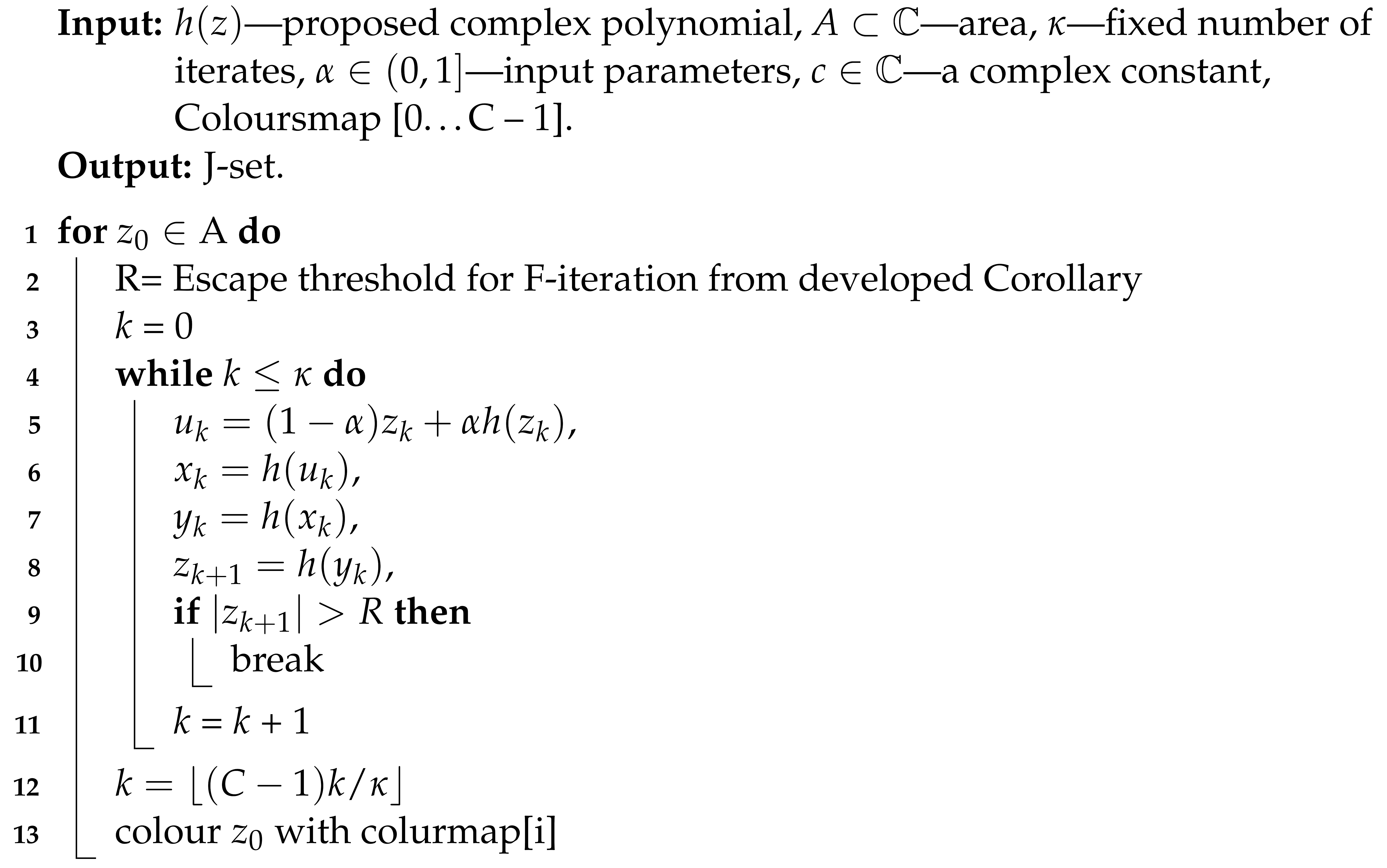 |
| Algorithm 2: Geometry of M-Set |
 |
| Algorithm 3: Geometry of Multi-corn |
 |
4.2. Mandelbrot Set
4.3. Multi-Corn
5. Conclusions
Author Contributions
Funding
Data Availability Statement
Acknowledgments
Conflicts of Interest
References
- Barnsley, M. Fractals Everywhere; Morgan Kaufmann Publishers: Burlington, MA, USA, 1993. [Google Scholar]
- Mandelbrot, B.B. The Fractal Geometry Nature; Freeman: New York, NY, USA, 1982; Volume 2. [Google Scholar]
- Lakhtakia, A.; Varadan, W.; Messier, R.; Varadan, V.K. On the symmetries of the Julia sets for the process zp + c. J. Phys. A Math. Gen. 1987, 20, 3533–3535. [Google Scholar] [CrossRef]
- Crowe, W.D.; Hasson, R.; Rippon, P.J.; Strain-Clark, P.E.D. On the structure of the Mandelbar set. Nonlinearity 1989, 2, 541. [Google Scholar] [CrossRef]
- Kim, T. Quaternion Julia set shape optimization. Comput. Graph. Forum 2015, 34, 167–176. [Google Scholar] [CrossRef]
- Drakopoulos, V.; Mimikou, N.; Theoharis, T. An overview of parallel visualisation methods for mandelbrot and Julia sets. Comput. Graph. 2003, 27, 635–646. [Google Scholar] [CrossRef]
- Rani, M.; Agarwal, R. Effect of stochastic noise on superior Julia sets. J. Math. Imag. Vis. 2010, 36, 63. [Google Scholar] [CrossRef]
- Prasad, B.; Katiyar, K. Fractals via Ishikawa iteration. In Proceedings of the International Conference on Logic, Information, Control and Computation, Gandhigram, India, 25–27 February 2011; pp. 197–203. [Google Scholar]
- Kang, S.M.; Rafiq, A.; Latif, A.; Shahid, A.A.; Kwun, Y.C. Tricorns and Multi-corns of S-iteration scheme. J. Funct. Spaces 2015, 2015, 1–7. [Google Scholar]
- Ashish, M.R.; Chugh, R. Julia sets and mandelbrot sets in Noor orbit. Appl. Math. Comput. 2014, 228, 615–631. [Google Scholar] [CrossRef]
- Phuengrattana, W.; Suantai, S. On the rate of convergence of Mann, Ishikawa, Noor and SP-iterations for continuous functions on an arbitrary interval. J. Comput. Appl. Math. 2011, 235, 3006–3014. [Google Scholar] [CrossRef]
- Chugh, R.; Kumar, V.; Kumar, S. Strong convergence of a new three step iterative scheme in Banach spaces. Amer. J. Comput. Math. 2012, 2, 345. [Google Scholar] [CrossRef]
- Kwun, Y.C.; Tanveer, M.; Nazeer, W.; Abbas, M.; Kang, S.M. Fractal generation in modified Jungck–S orbit. IEEE Access 2019, 7, 35060–35071. [Google Scholar] [CrossRef]
- Kwun, Y.C.; Tanveer, M.; Nazeer, W.; Gdawiec, K.; Kang, S.M. Mandelbrot and Julia sets via Jungck-CR iteration with s-convexity. IEEE Access 2019, 7, 12167–12176. [Google Scholar] [CrossRef]
- Li, D.; Tanveer, M.; Nazeer, W.; Guo, X. Boundaries of filled Julia sets in generalized Jungck-Mann orbit. IEEE Access 2019, 7, 76859–76867. [Google Scholar] [CrossRef]
- Li, X.; Tanveer, M.; Abbas, M.; Ahmad, M.; Kwun, Y.C.; Liu, J. Fixed point results for fractal generation in extended Jungck-SP orbit. IEEE Access 2019, 7, 160472–160481. [Google Scholar] [CrossRef]
- Pickover, C.A. Biom orphs: Computer displays of biological forms generated from mathematical feedback loops. Comput. Graph. Forum 1986, 5, 313–316. [Google Scholar] [CrossRef]
- Gdawiec, K.; Kotarski, W.; Lisowska, A. Biomorphs via modified iterations. J. Nonlinear Sci. Appl. 2016, 9, 2305–2315. [Google Scholar] [CrossRef]
- Alonso-Sanz, R. Biomorphs with memory. Int. J. Parallel Emergent Distrib. Syst. 2018, 33, 1–11. [Google Scholar] [CrossRef]
- Qi, H.; Tanveer, M.; Nazeer, W.; Chu, Y. Fixed Point Results for Fractal Generation of Complex Polynomials Involving Sine Function via Non-Standard Iterations. IEEE Access 2020, 8, 154301–154317. [Google Scholar] [CrossRef]
- Wang, W.; Hu, X.; Shahid, A.A.; Wang, M. Generation of Antifractals via Hybrid Picard-Mann Iteration. IEEE Access 2020, 8, 83974–83985. [Google Scholar] [CrossRef]
- Ali, J.; Ali, F. A new iterative scheme for approximating fixed points with an application to a delay diferential equation. J. Nonlinear Convex Anal. 2020, 21, 2151–2163. [Google Scholar]
- Devaney, R. A First Course in Chaotic Dynamical Systems: Theory and Experiment; Addison-Wesley: New York, NY, USA, 1992. [Google Scholar]
- Liu, X.; Zhu, Z.; Wang, G.; Zhu, W. Composed accelerated escape time algorithm to construct the general mandelbrot sets. Fractals 2001, 9, 149–153. [Google Scholar] [CrossRef]
- Mann, W.R. Mean value methods in iteration. Proc. Amer. Math. Soc. 1953, 4, 506–510. [Google Scholar] [CrossRef]
- Ishikawa, S. Fixed points by a new iteration method. Proc. Amer. Math. Soc. 1974, 44, 147–150. [Google Scholar] [CrossRef]
- Strotov, V.V.; Smirnov, S.A.; Korepanov, S.E.; Cherpalkin, A.V. Object distance estimation algorithm for real-time fpga-based stereoscopic vision system. High-Perform. Comput. Geosci. Remote Sens. 2018, 10792, 71–78. [Google Scholar]
- Khatib, O. Real-Time Obstacle Avoidance for Manipulators and Mobile Robots, in Autonomous Robot Vehicles; Springer: Berlin/Heidelberg, Germany, 1986; pp. 396–404. [Google Scholar]
- Barrallo, J.; Jones, D.M. Coloring algorithms for dynamical systems in the complex plane. In Visual Mathematics; Mathematical Institute SASA: Belgrade, Serbia, 1999; Volume 1. [Google Scholar]
- Tassaddiq, A. General escape criteria for the generation of fractals in extended Jungck–Noor orbit. Math. Comput. Simul. 2022, 196, 1–14. [Google Scholar] [CrossRef]
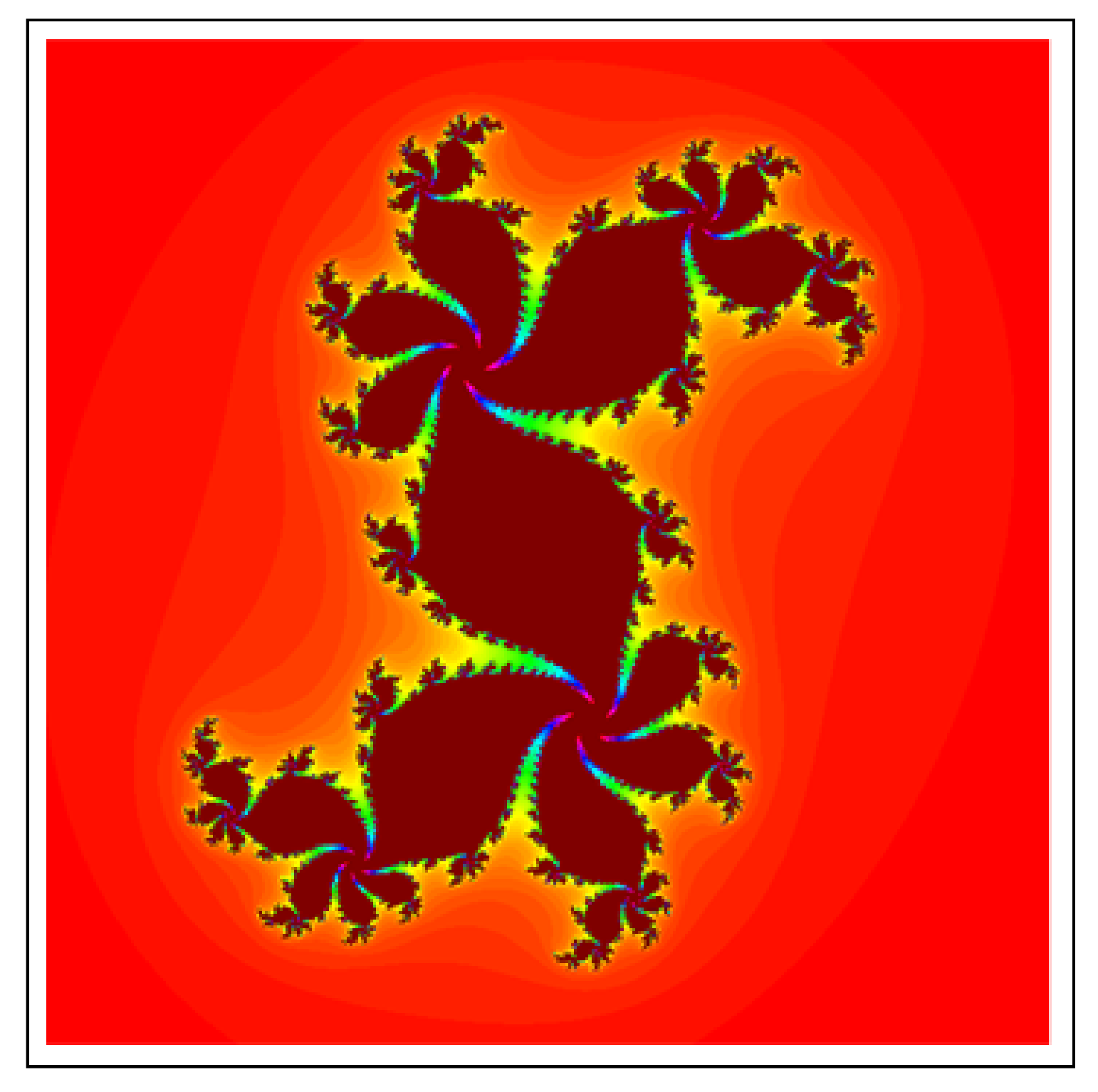
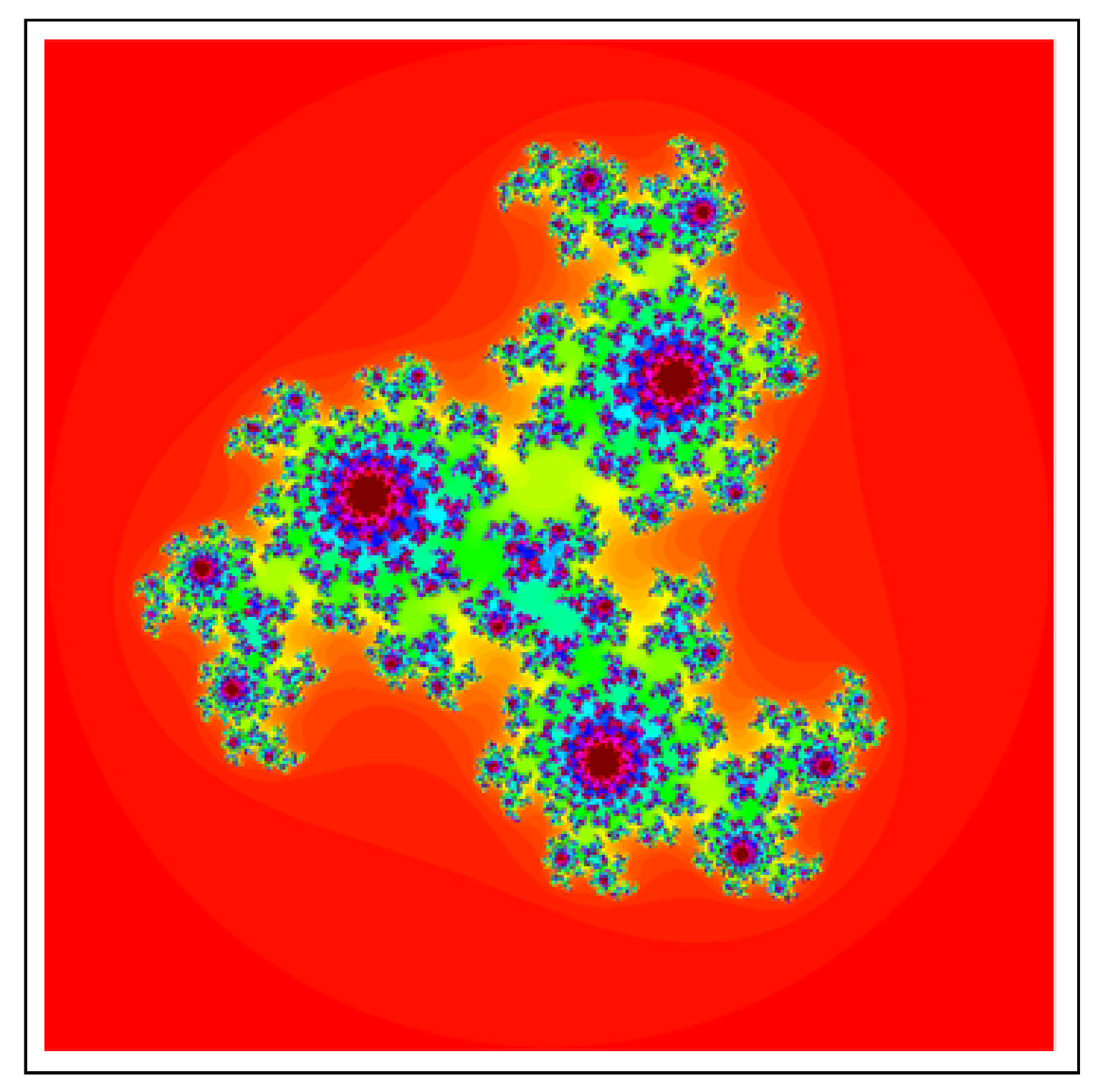
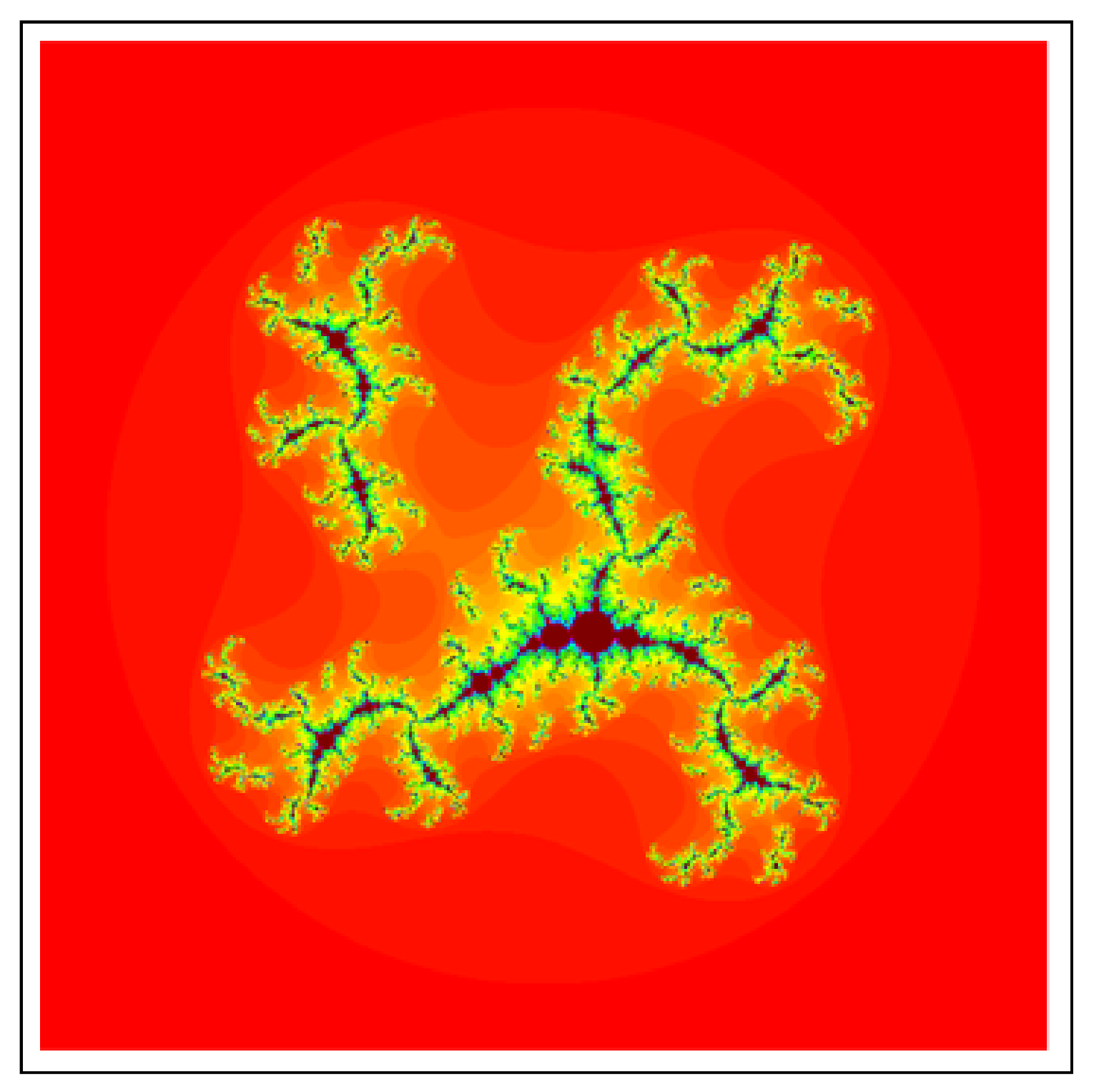
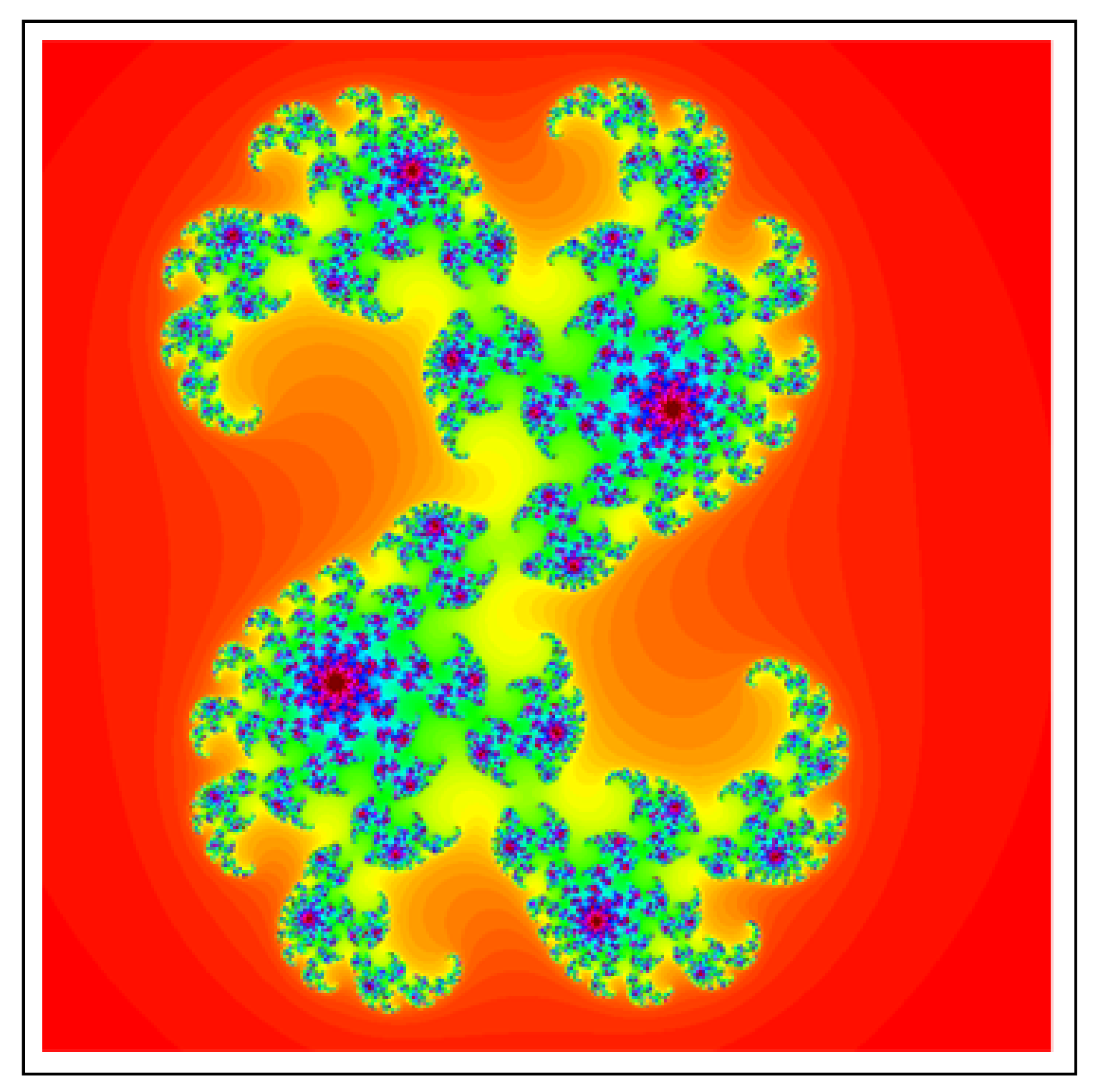

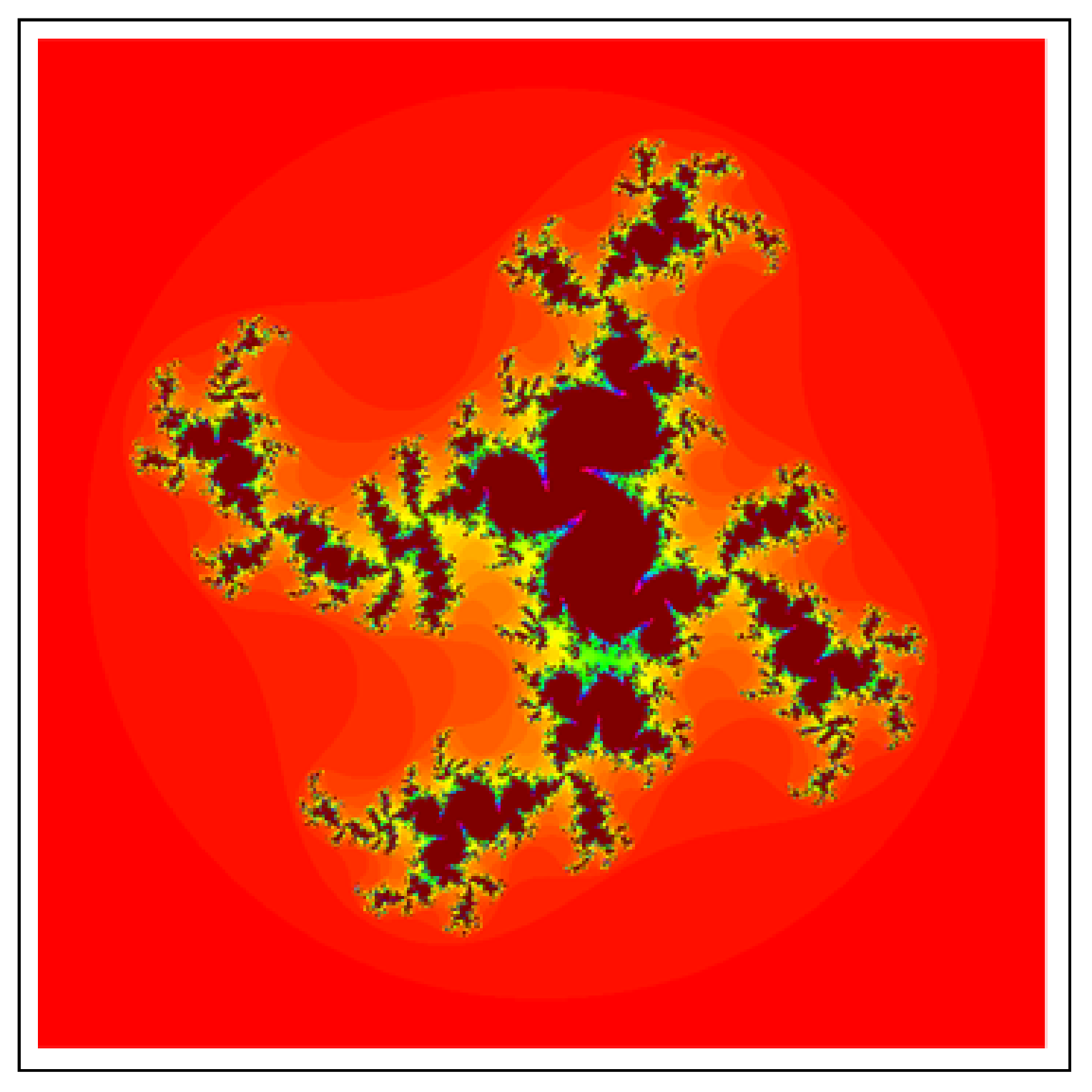
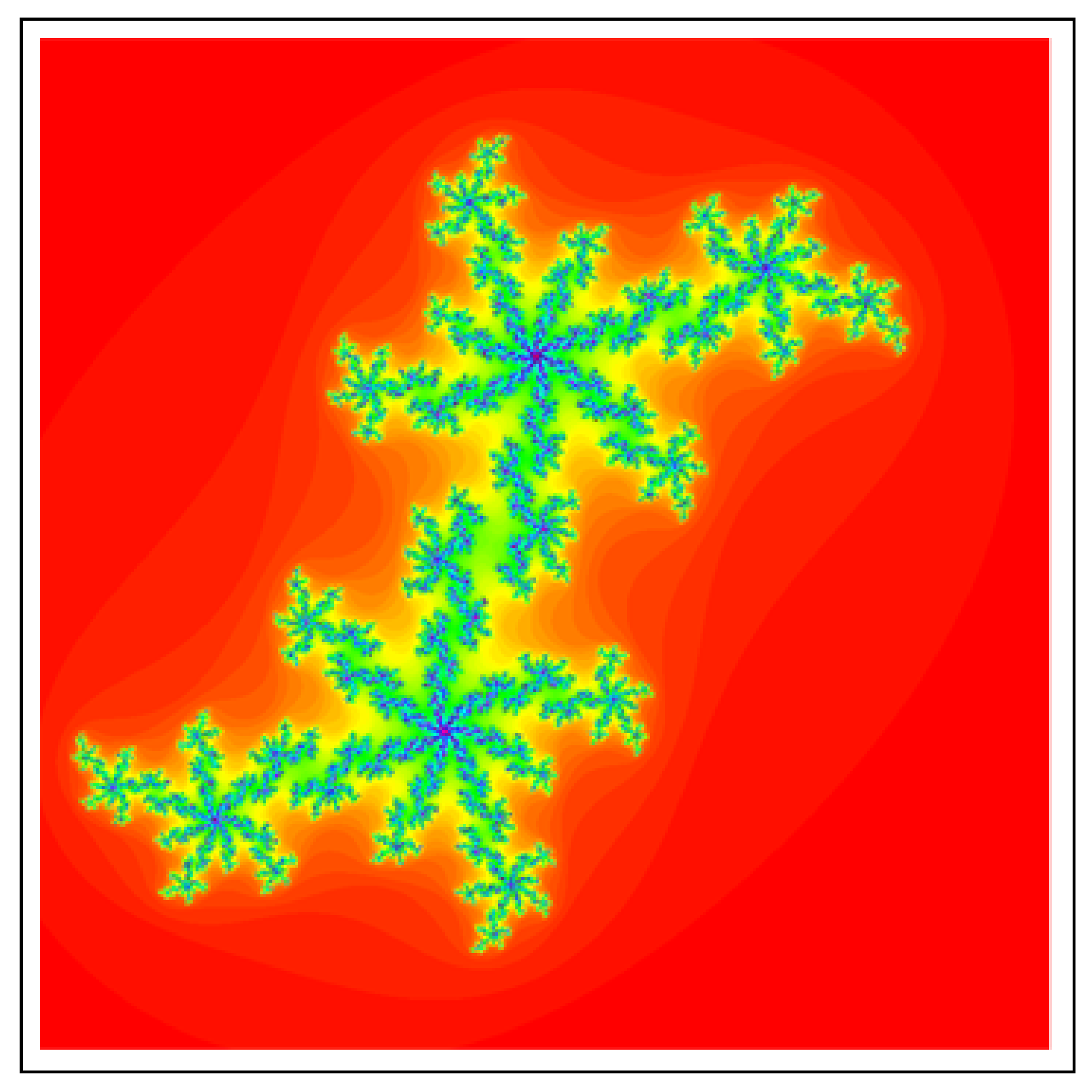
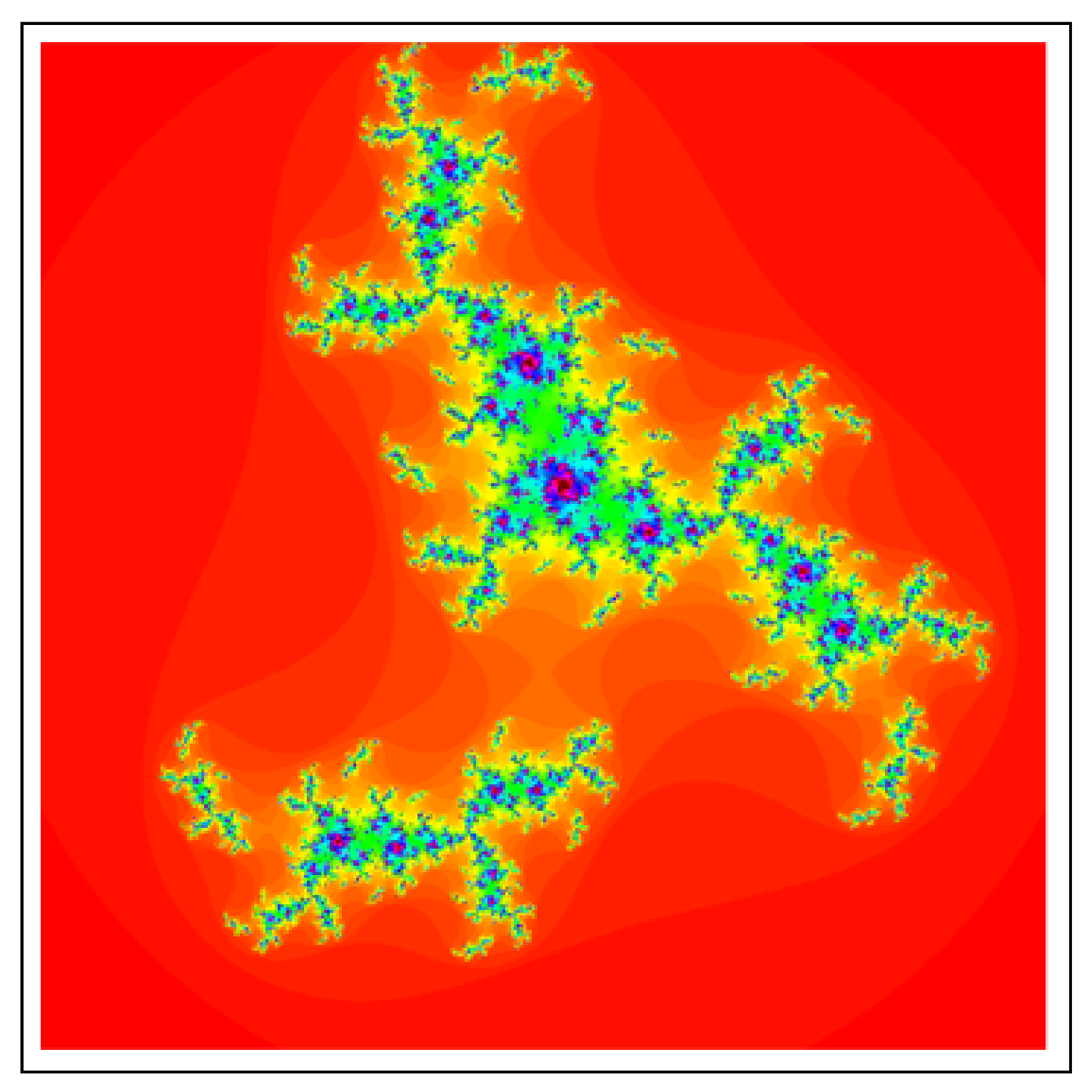
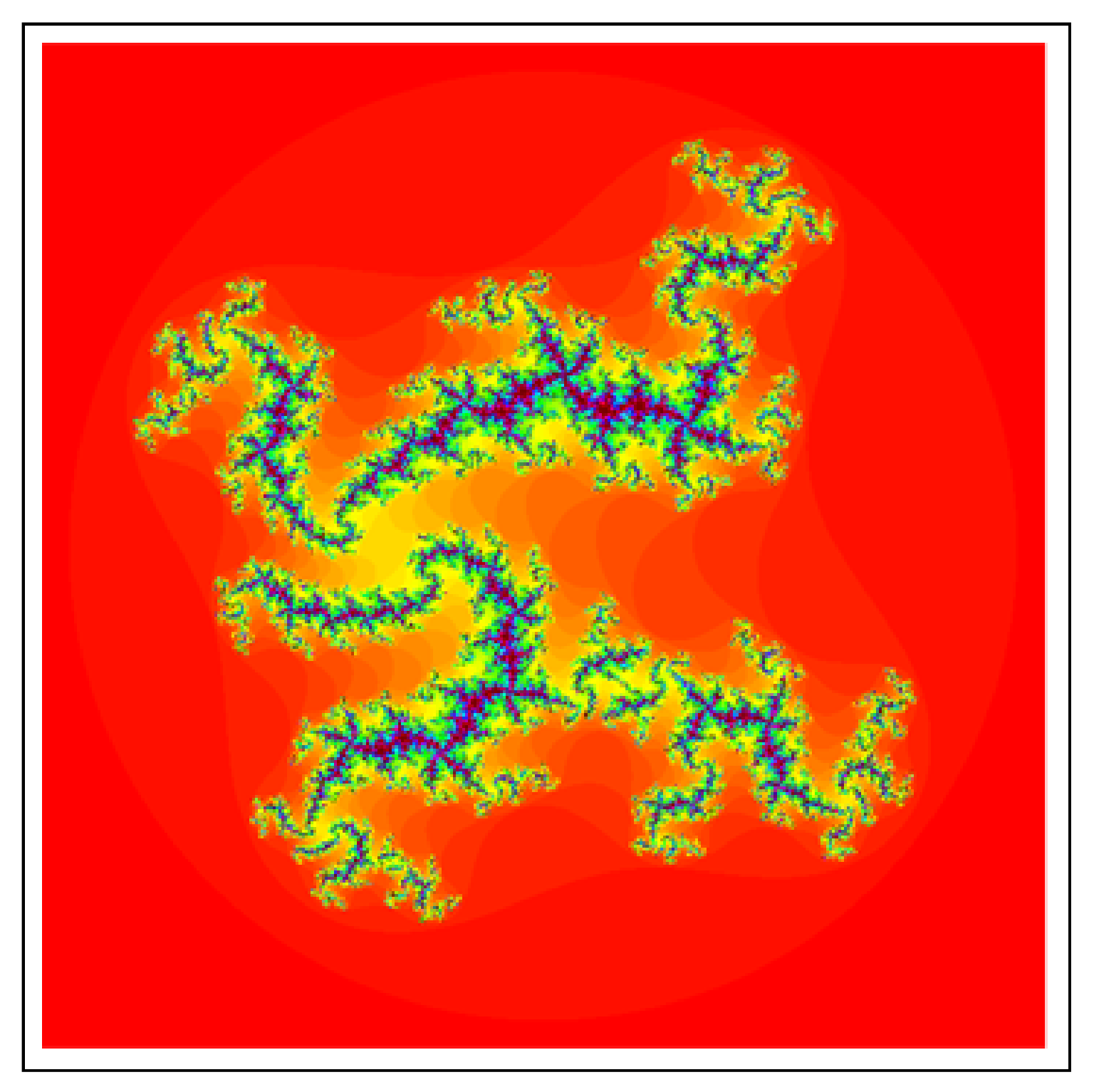
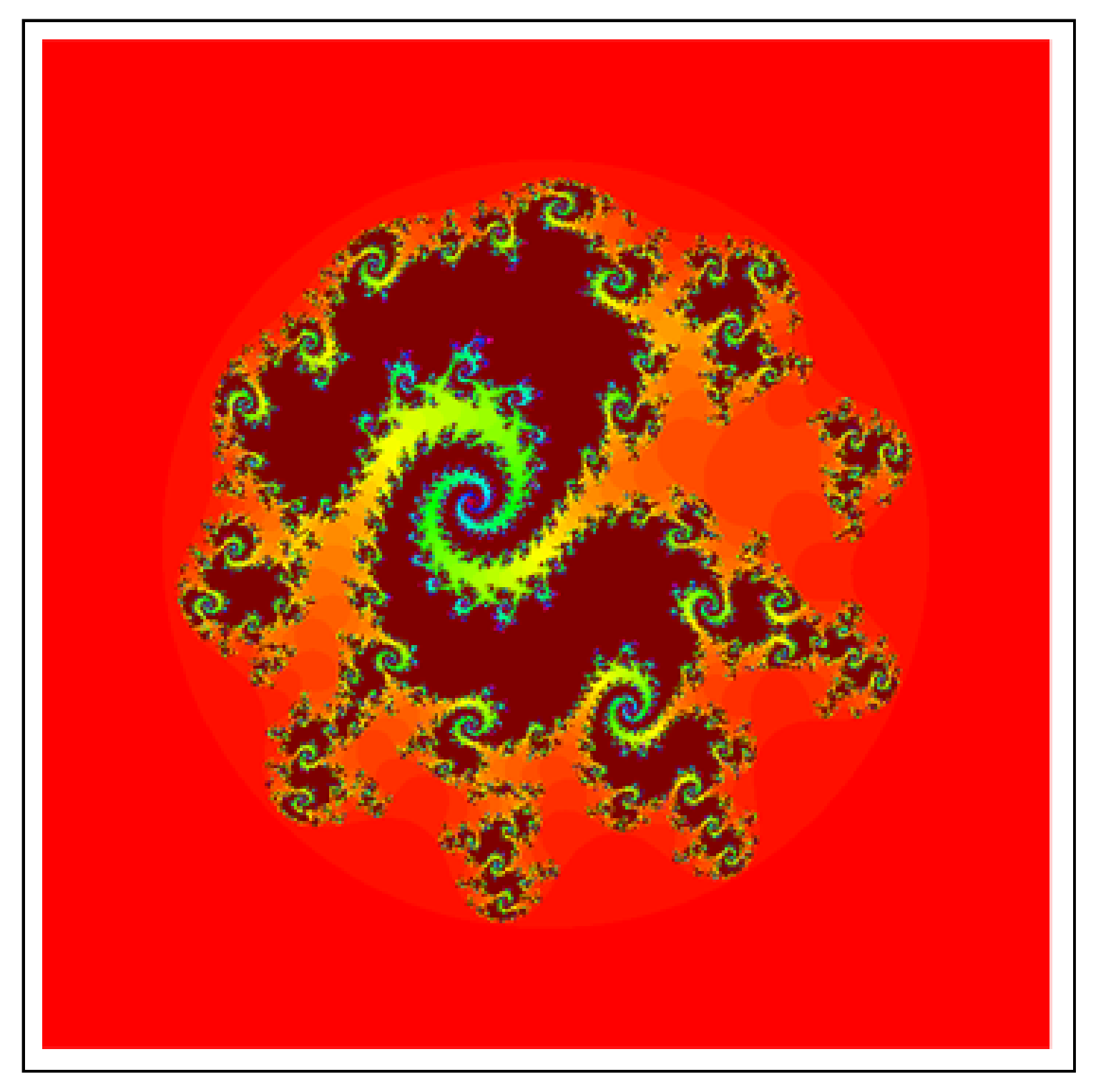
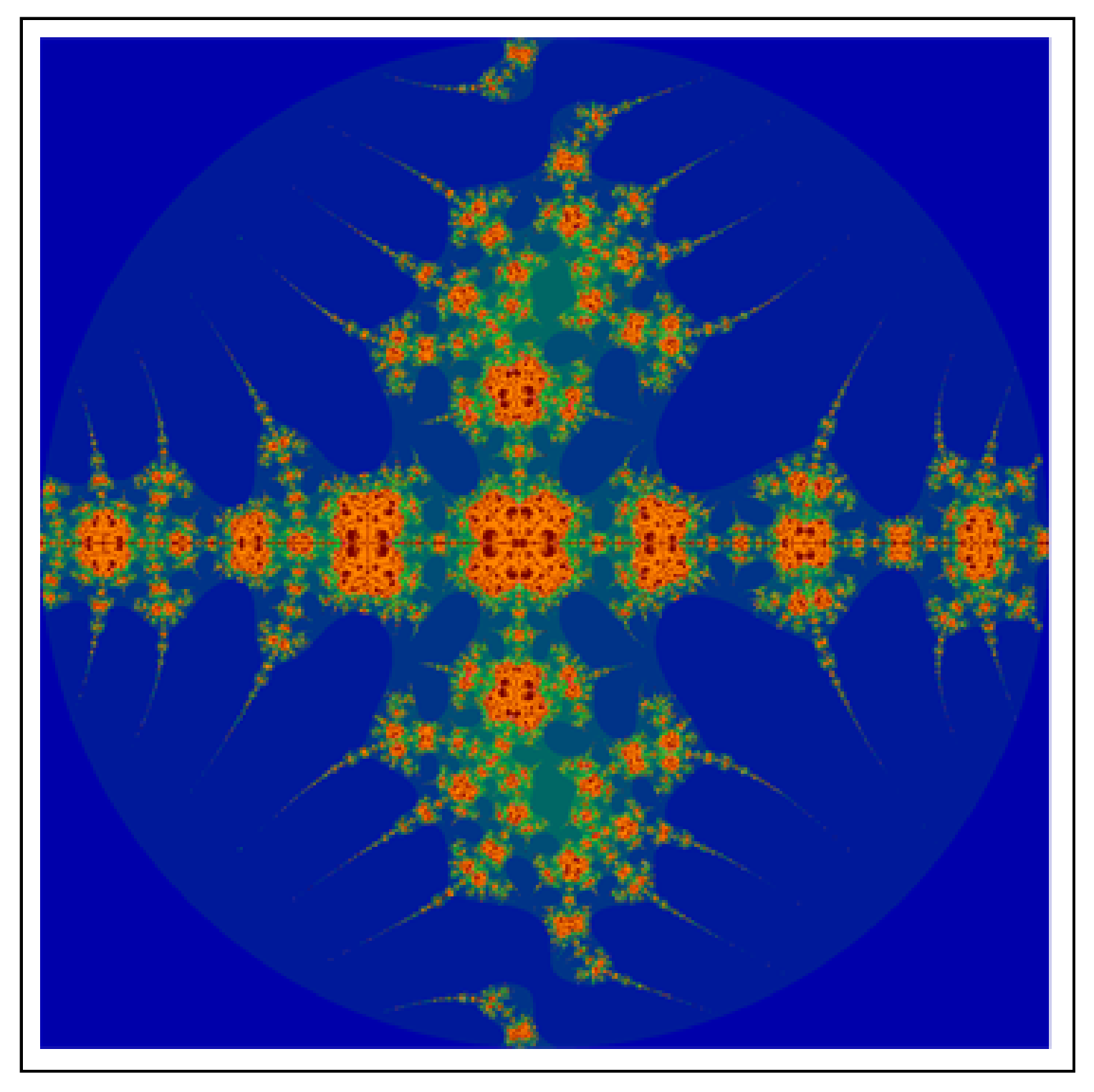

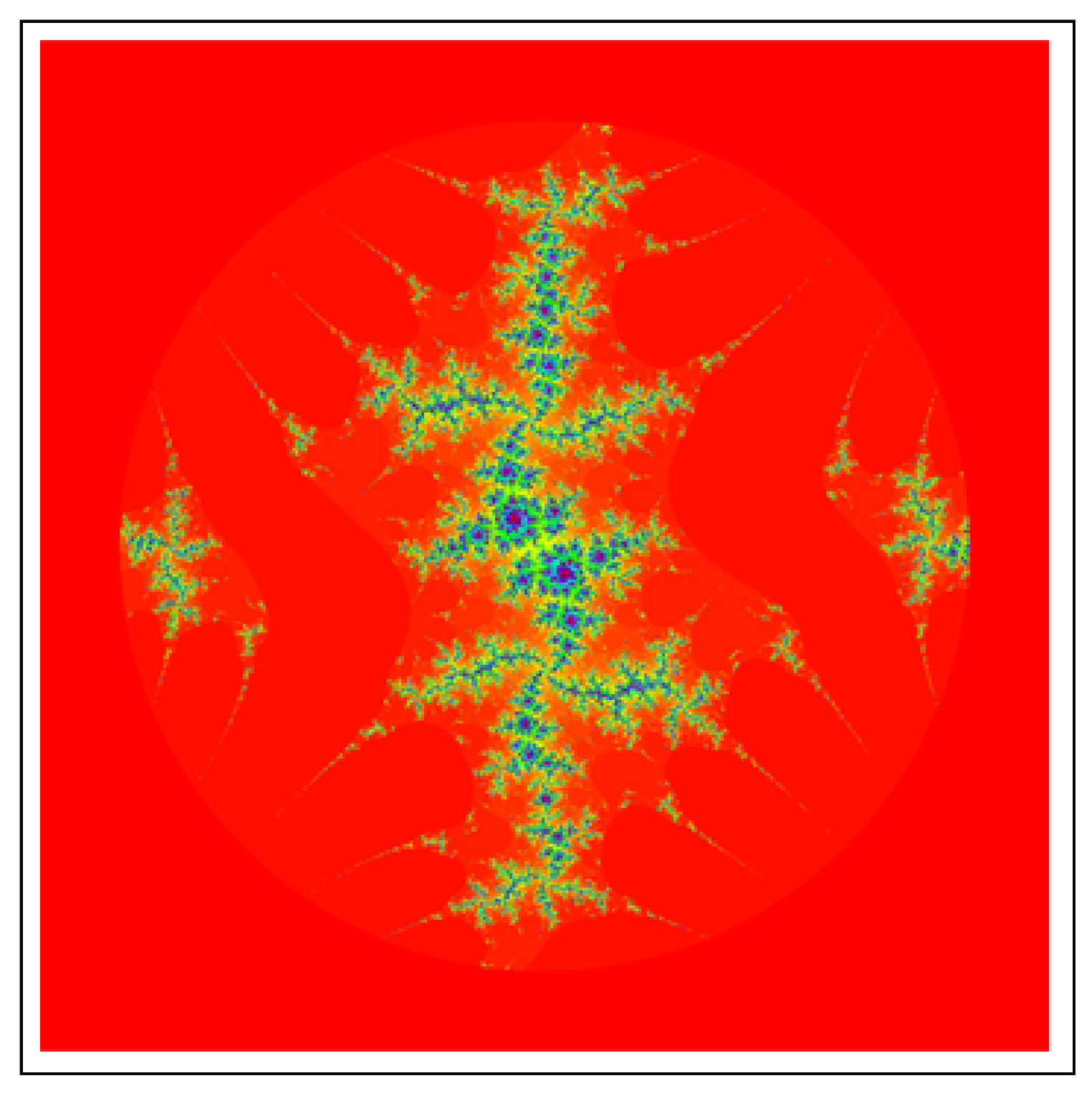


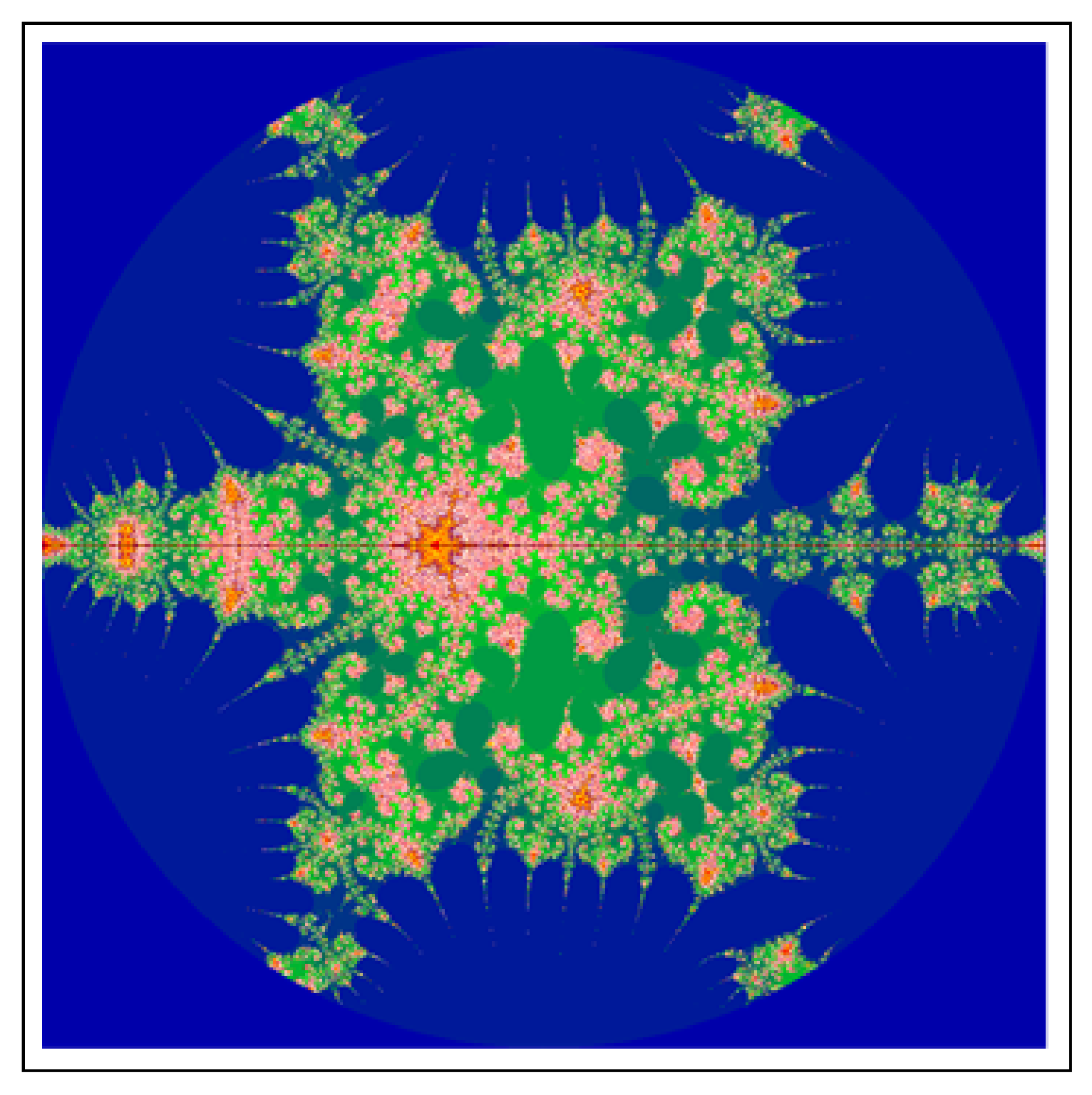
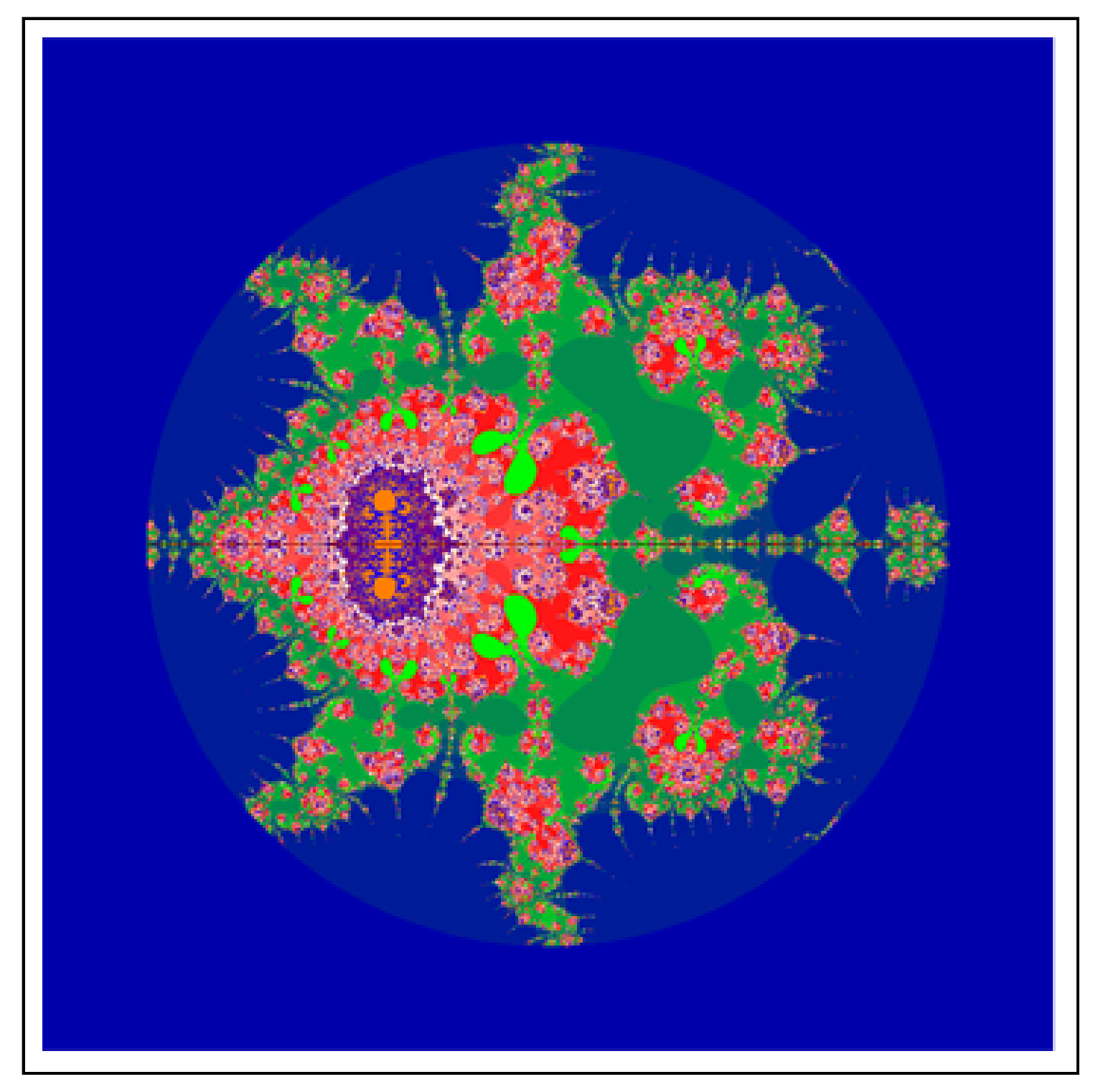
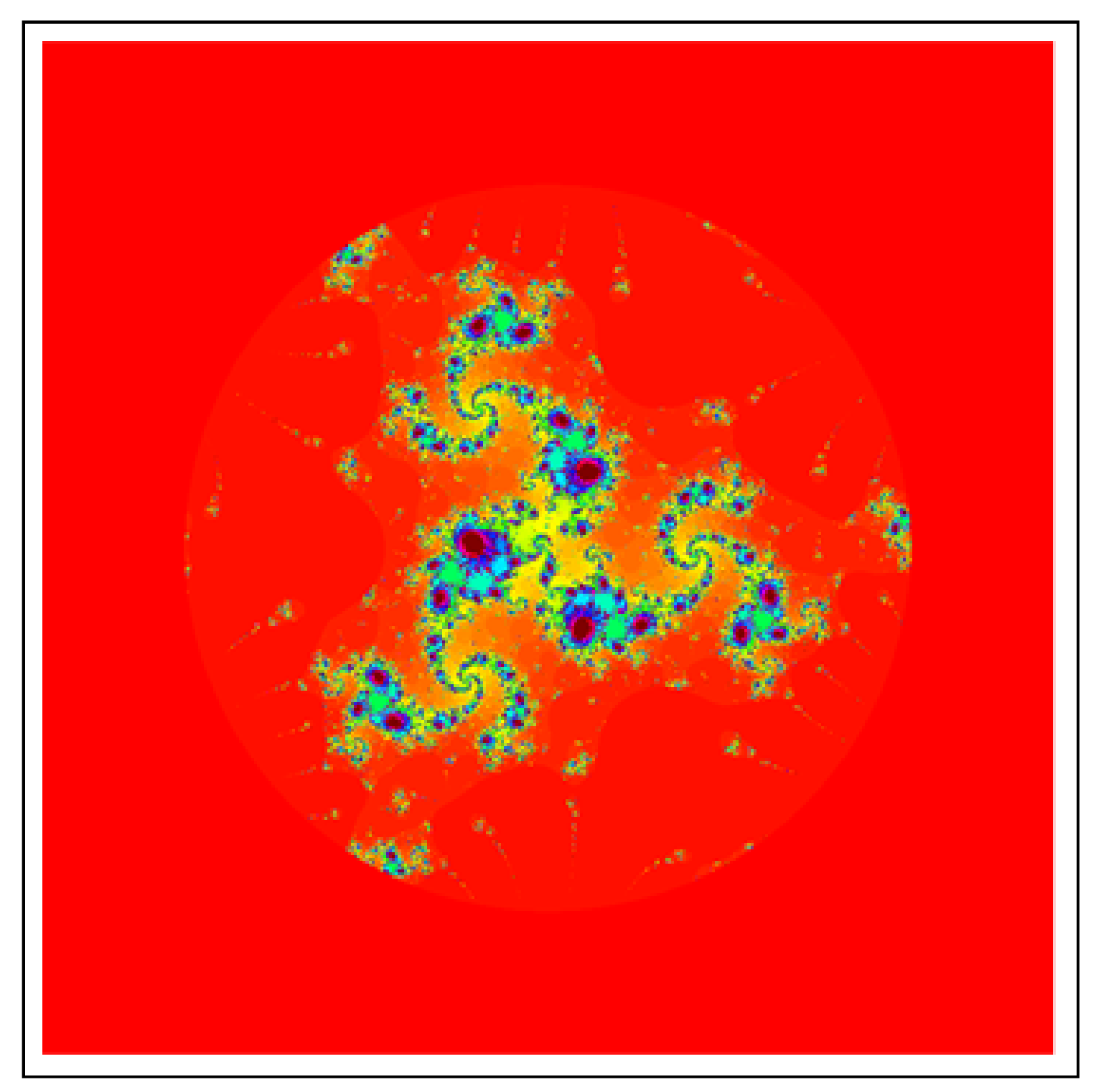
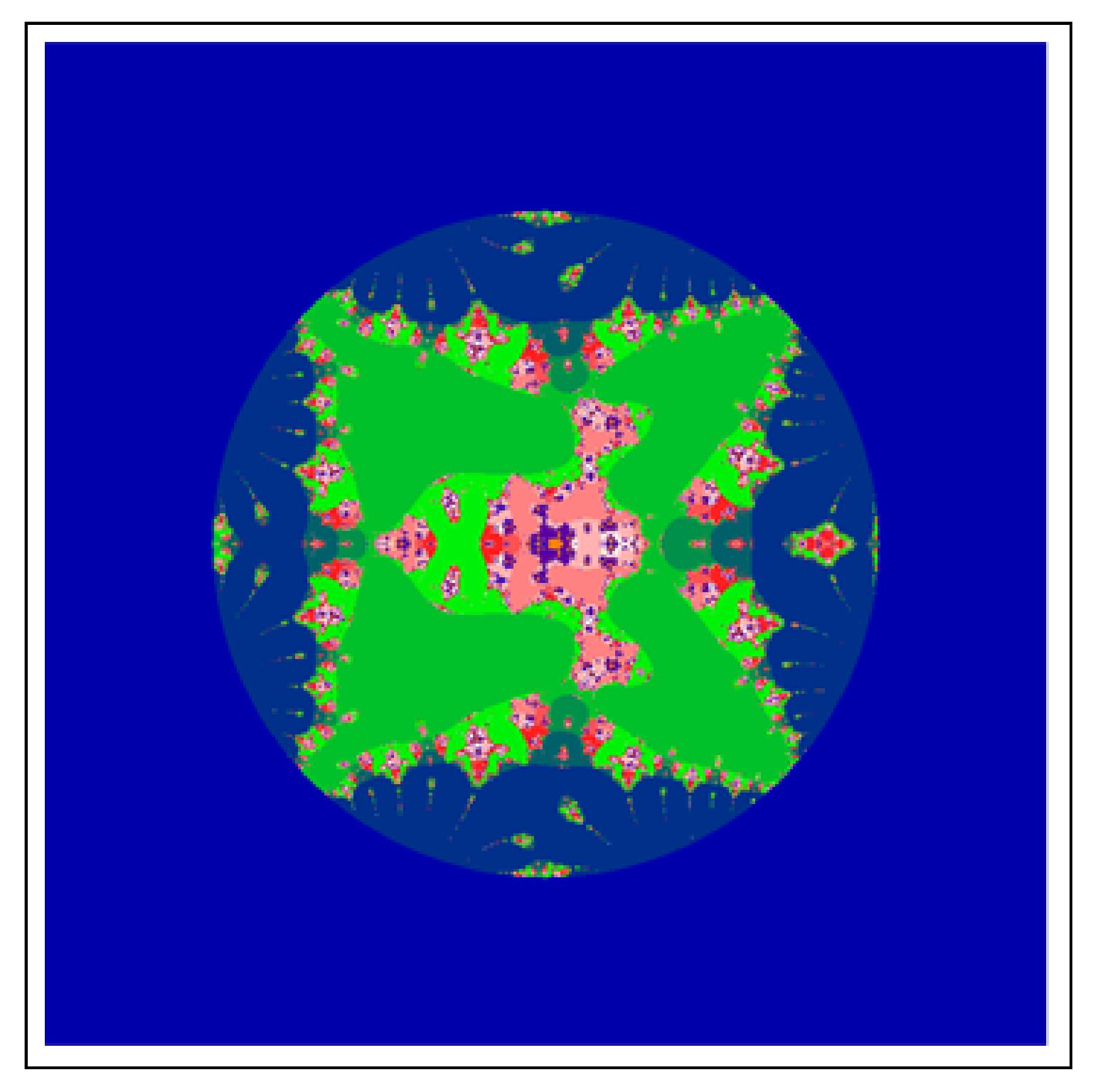

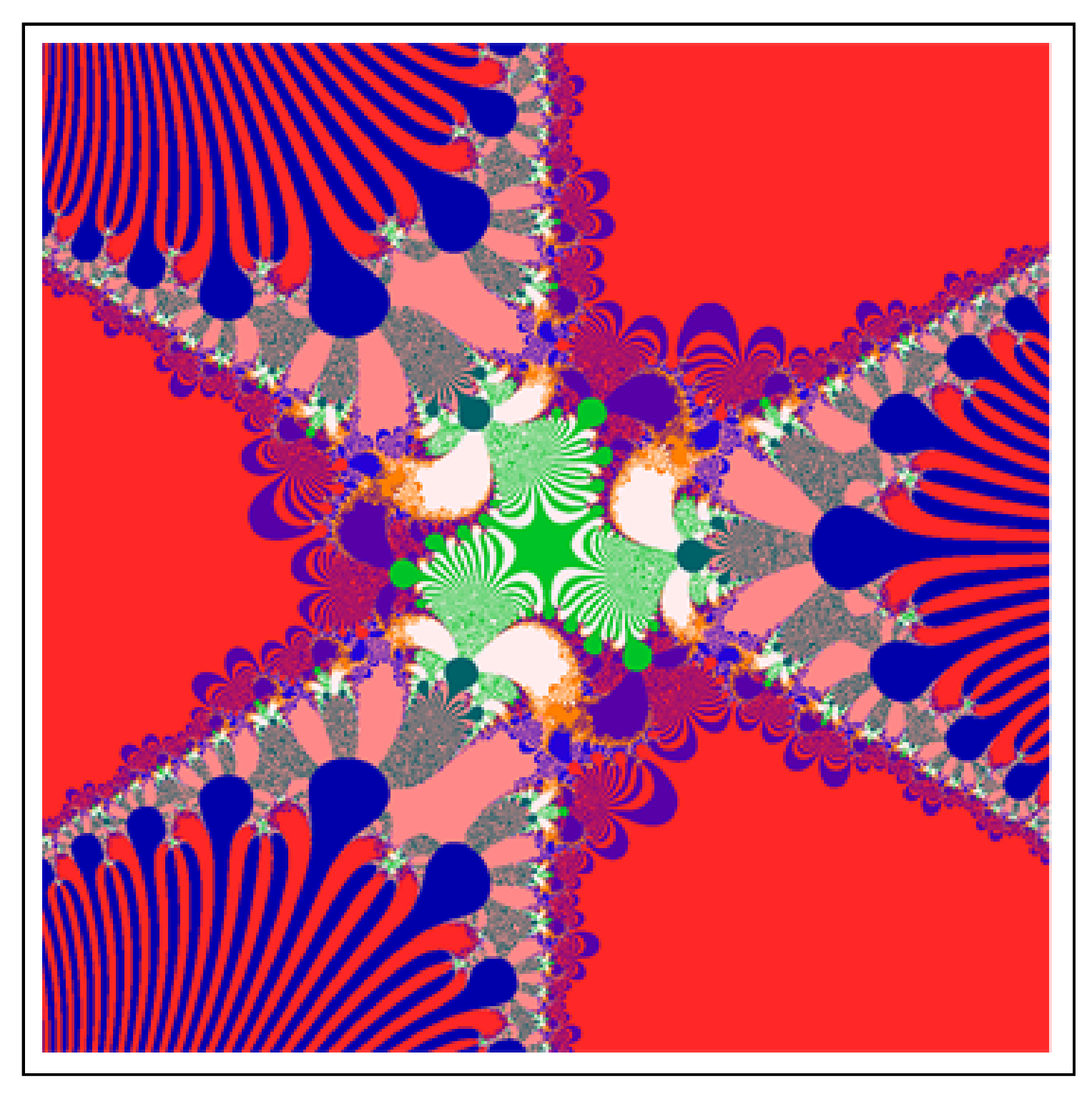
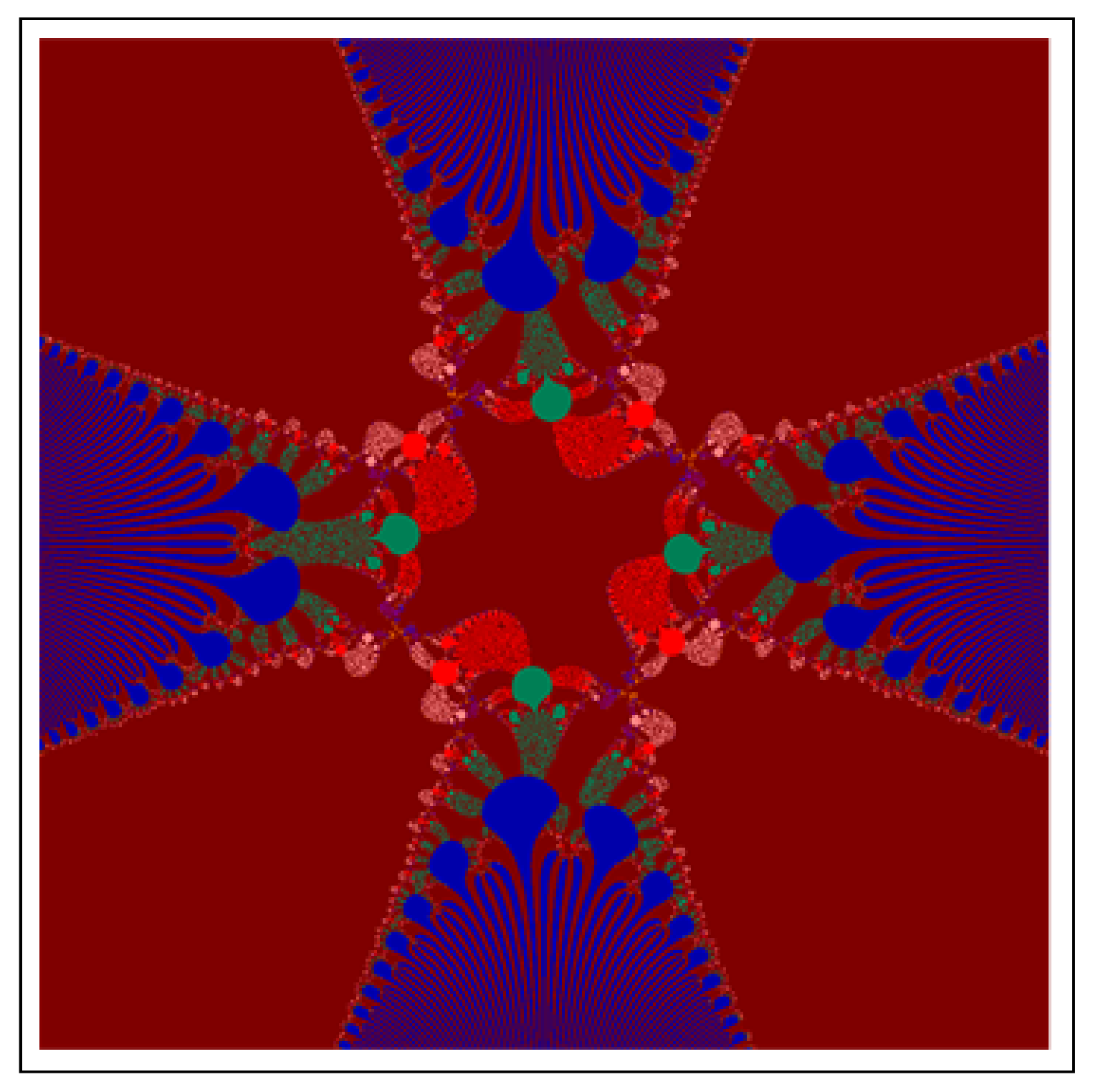
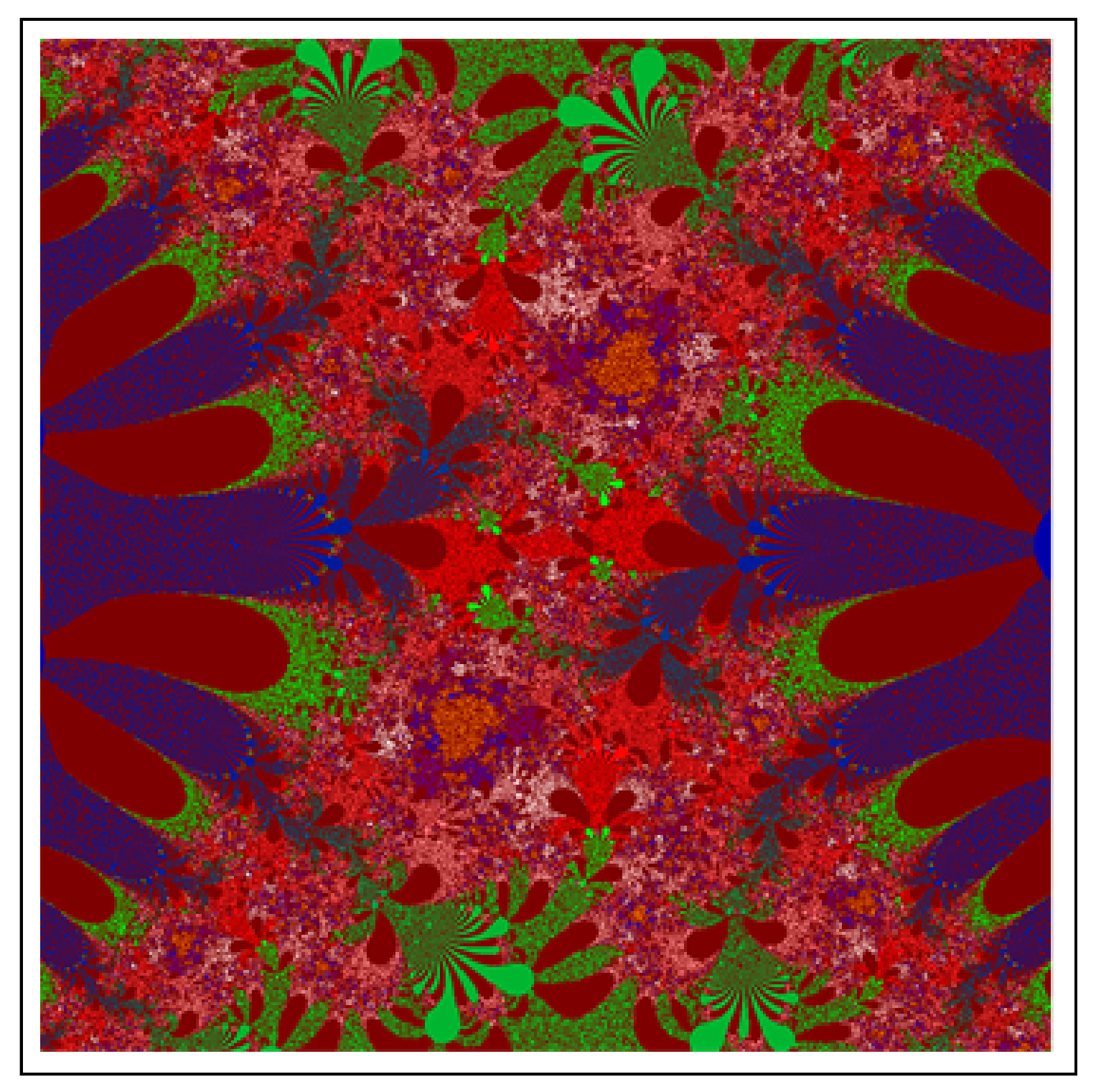
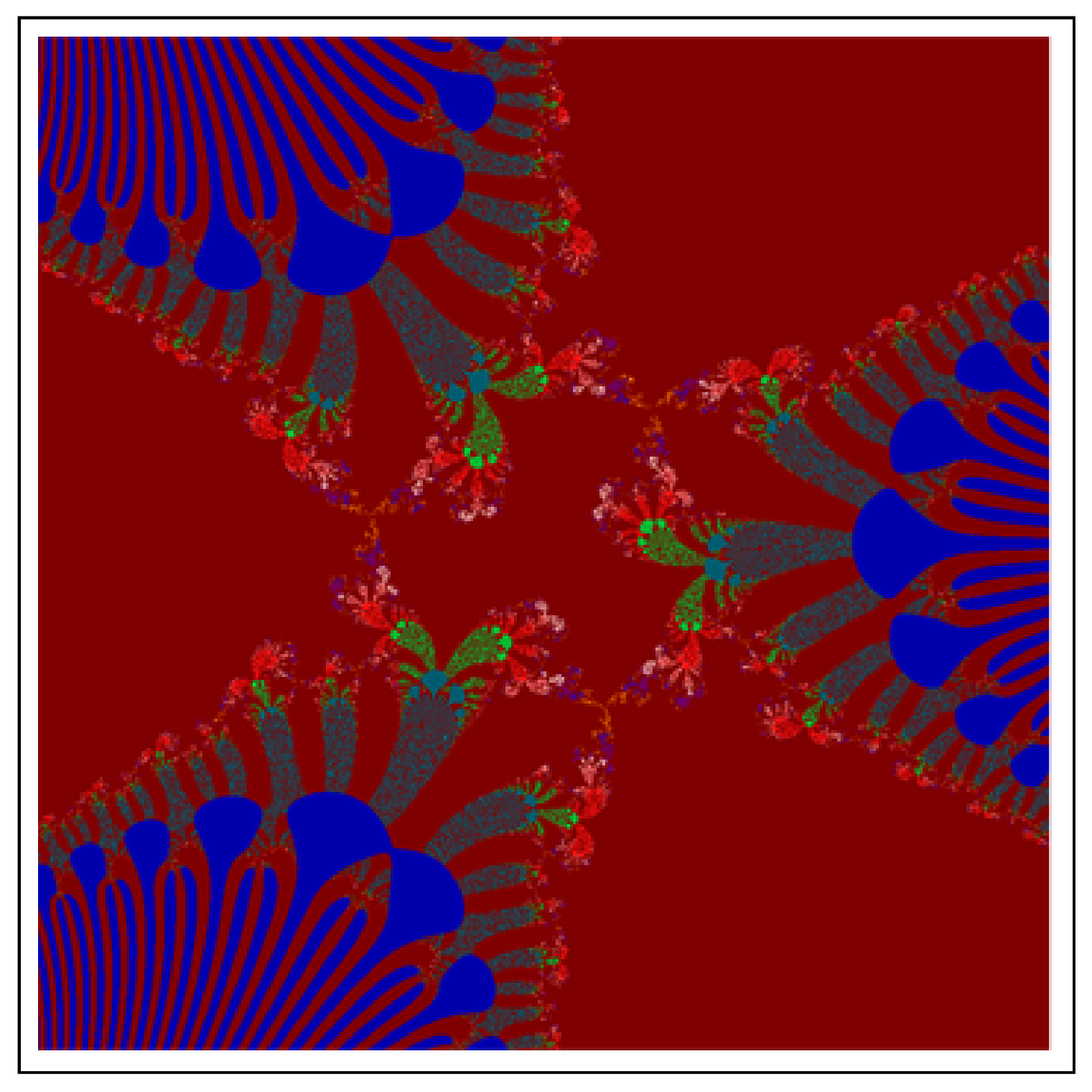
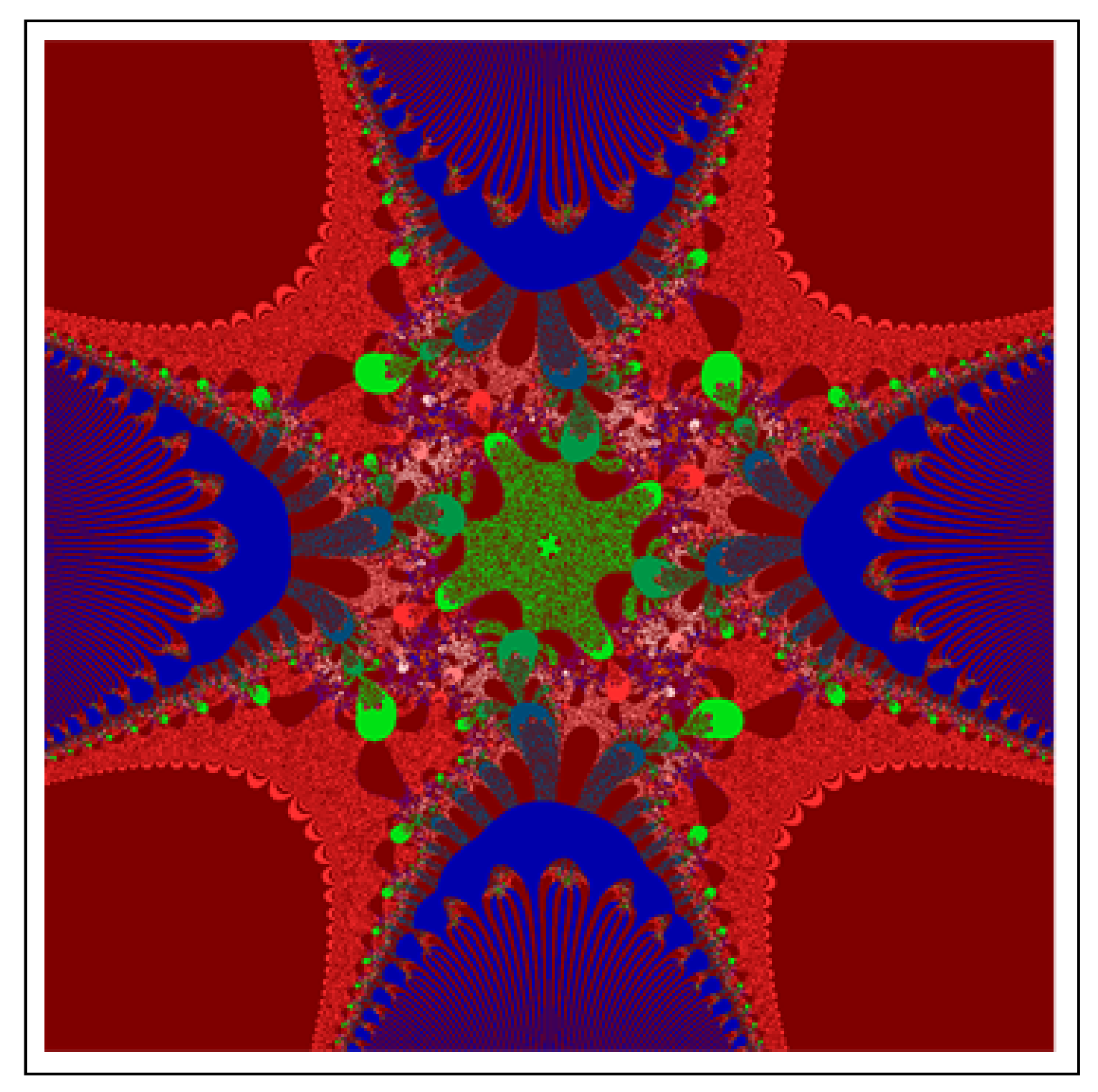

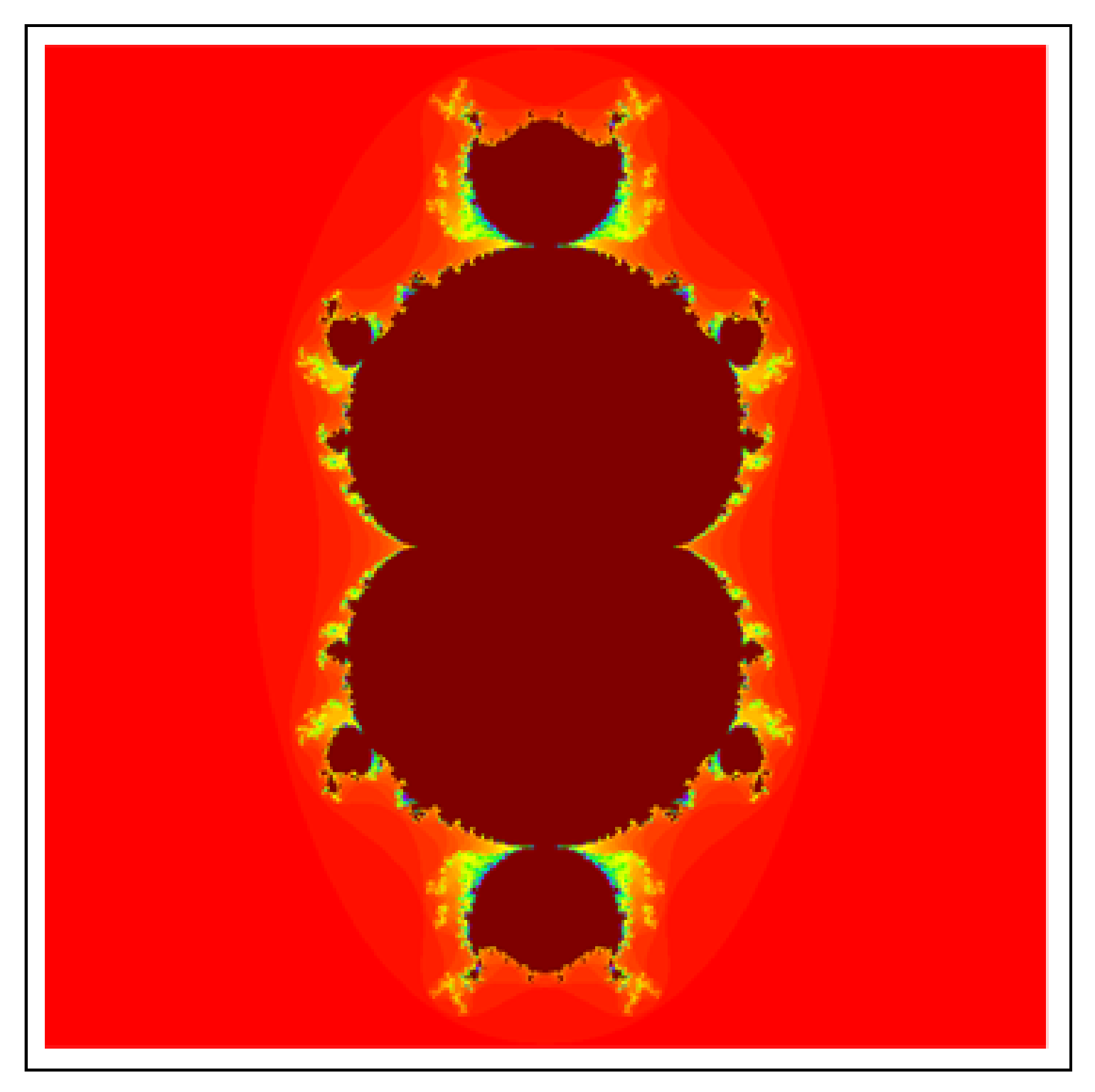
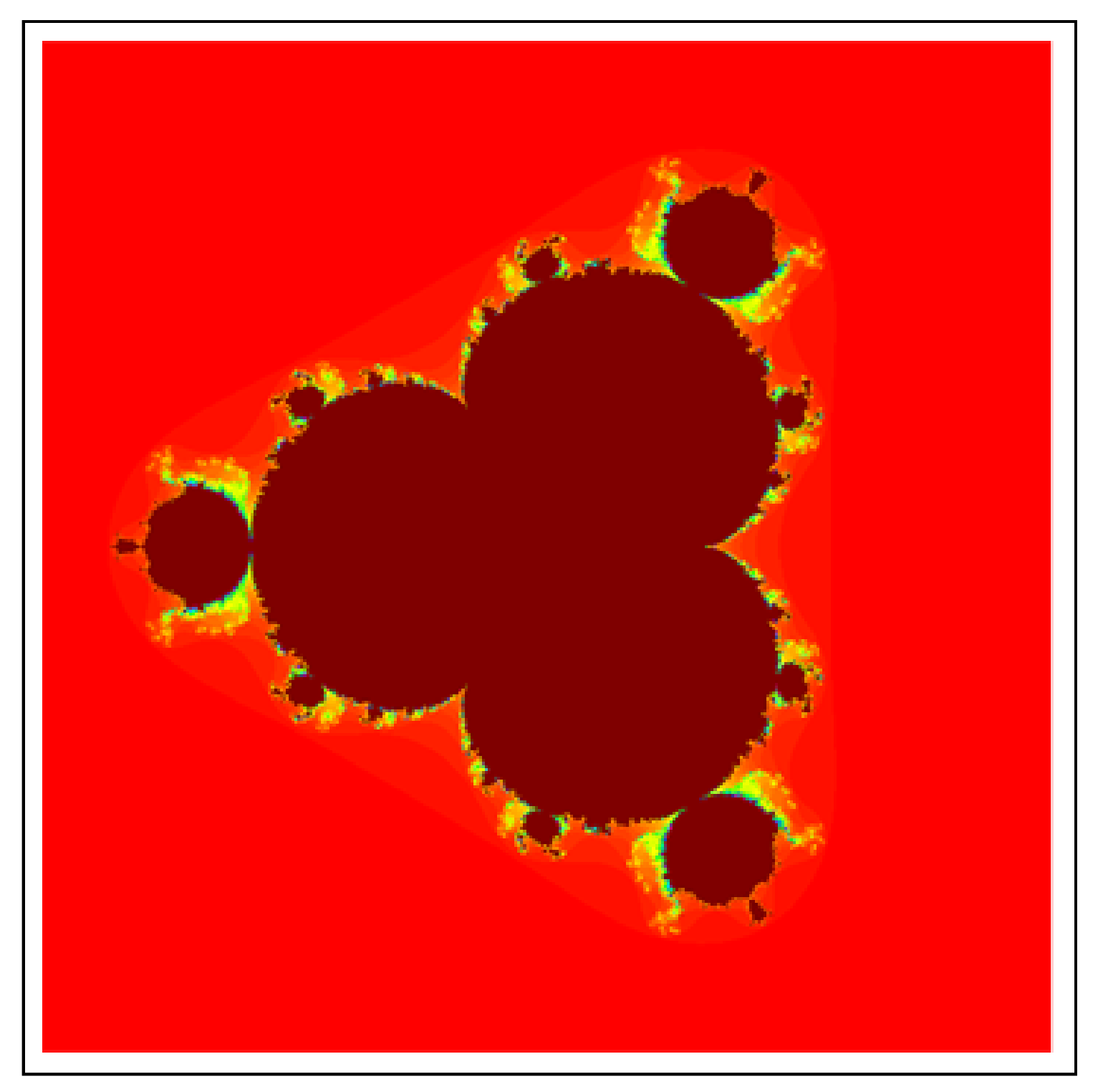
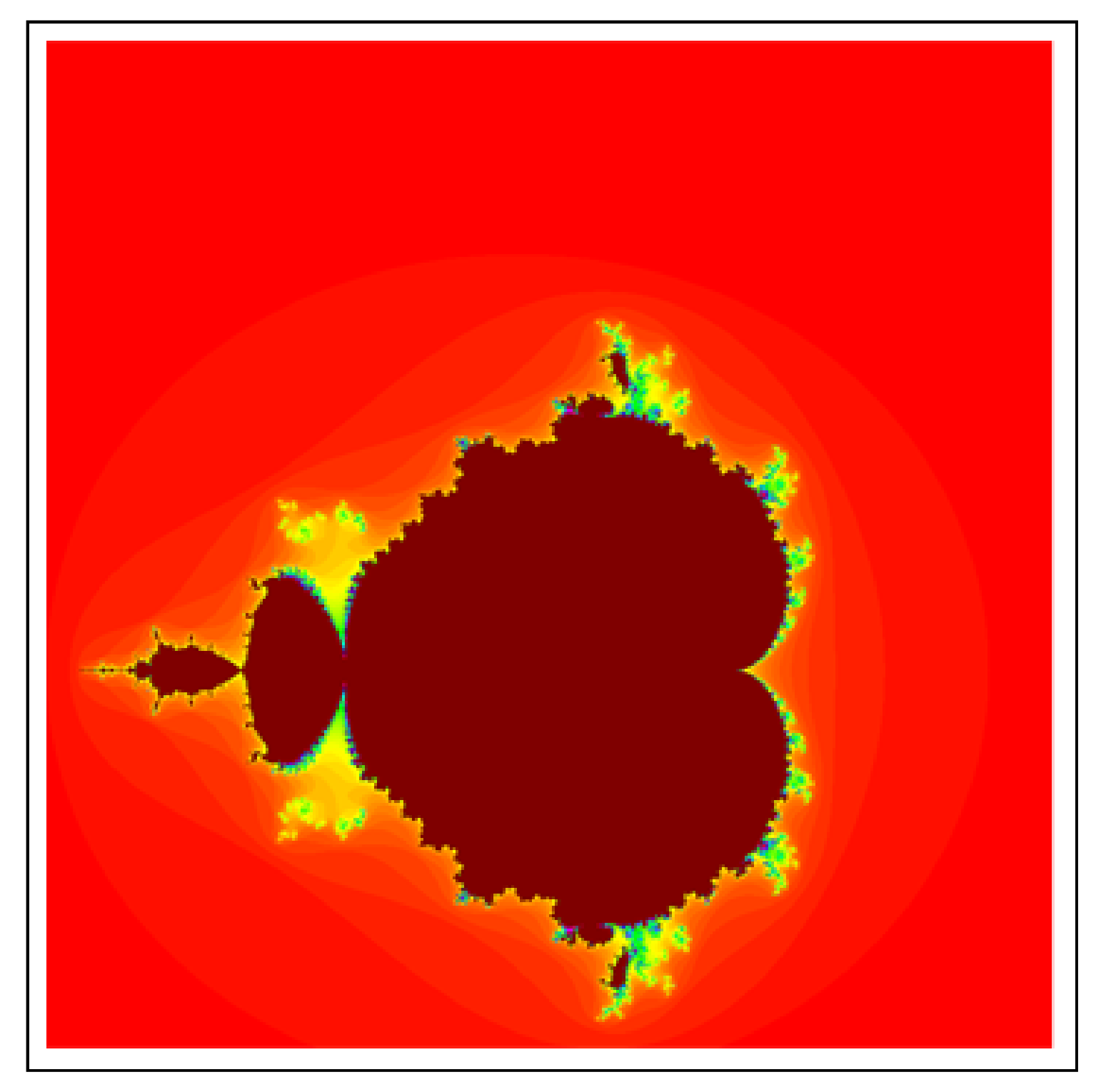
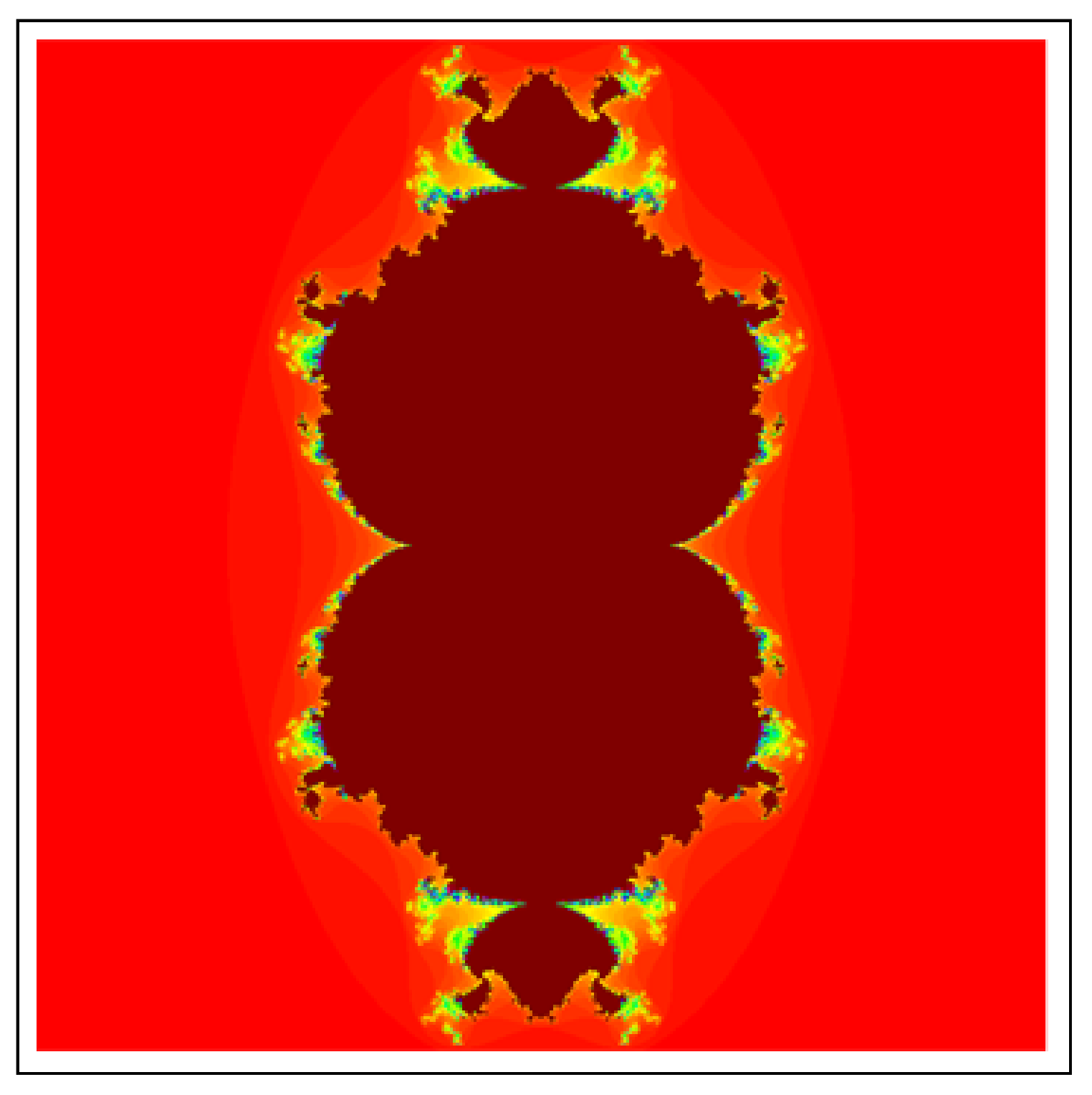
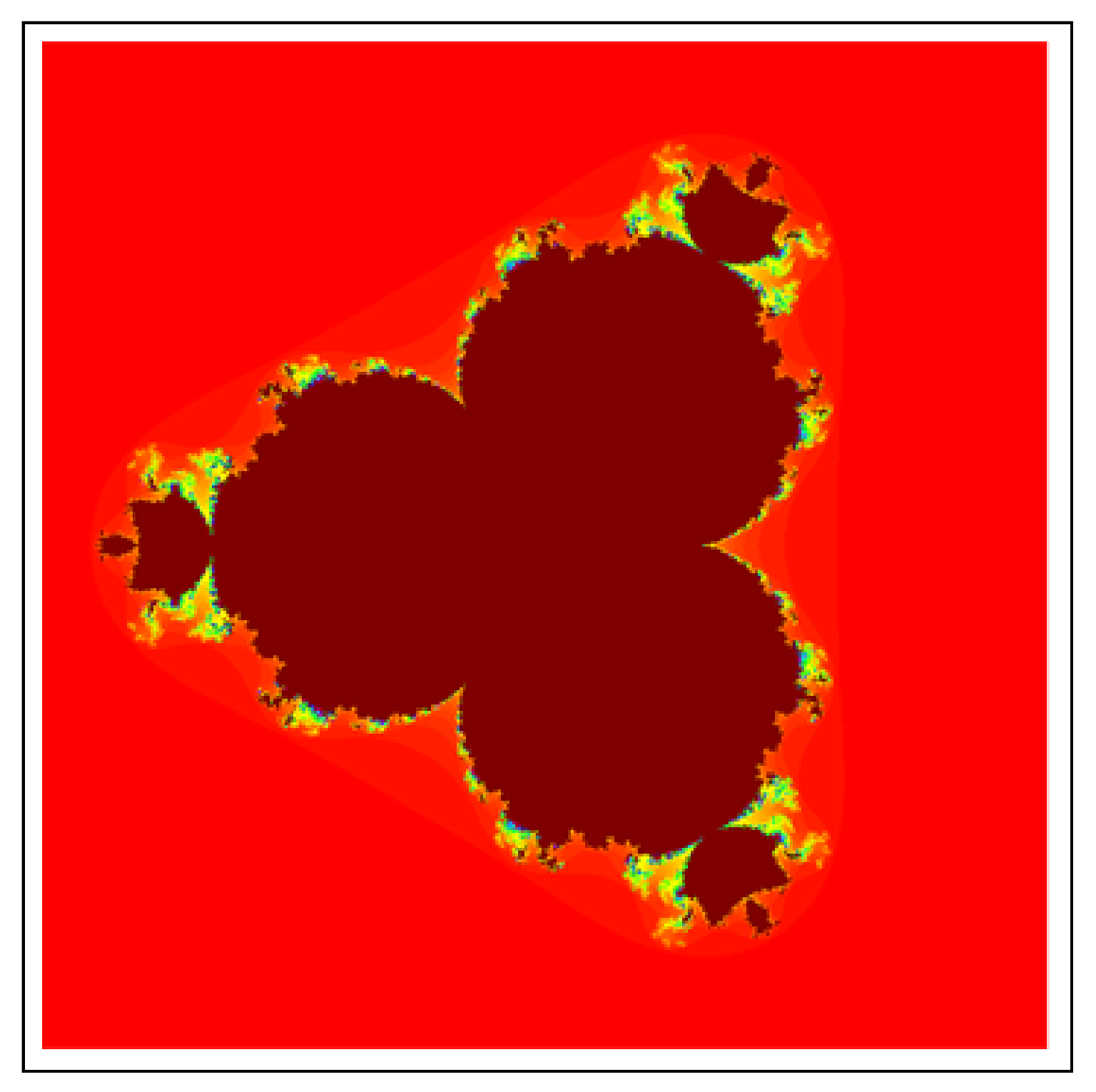
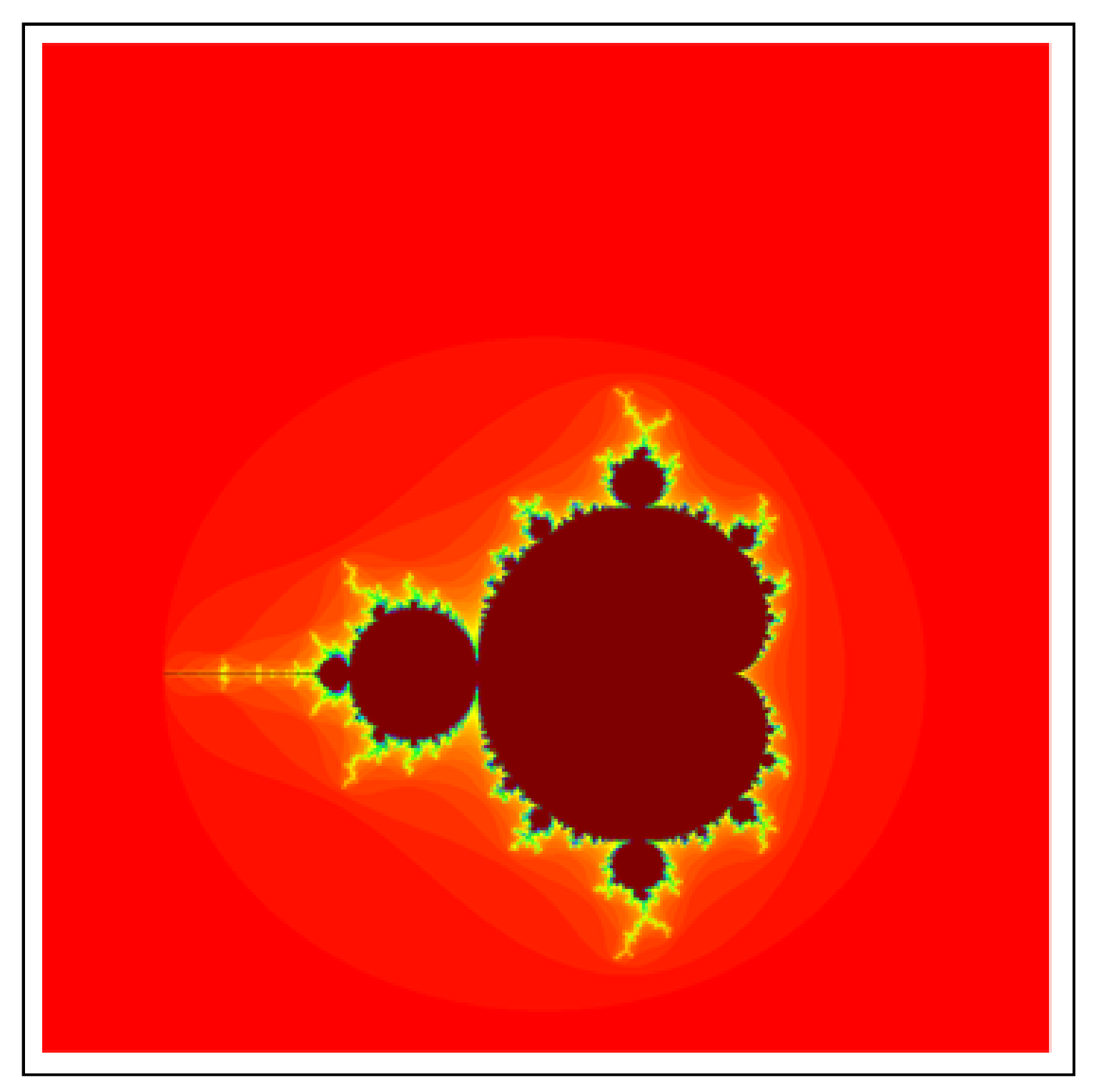
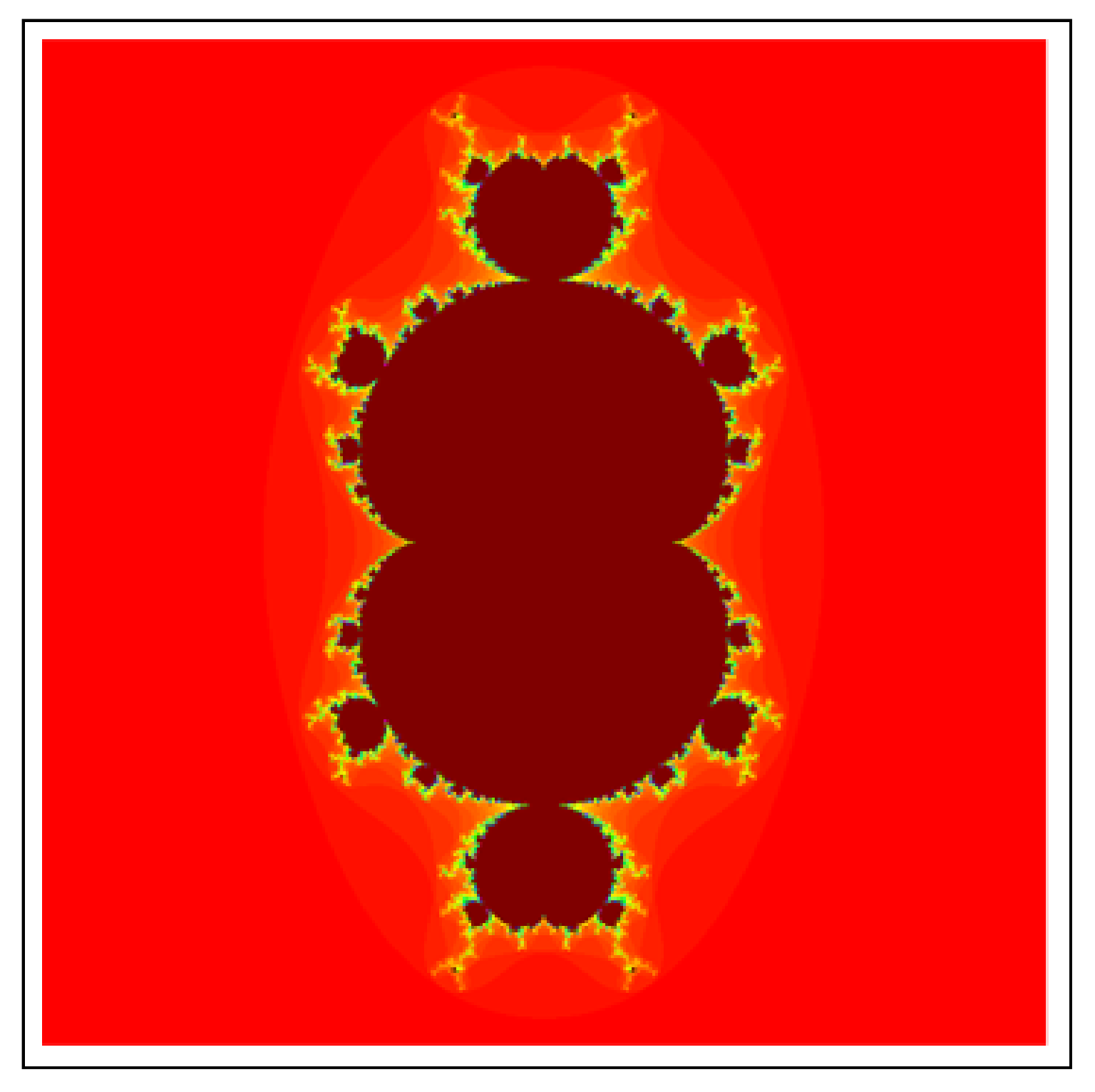
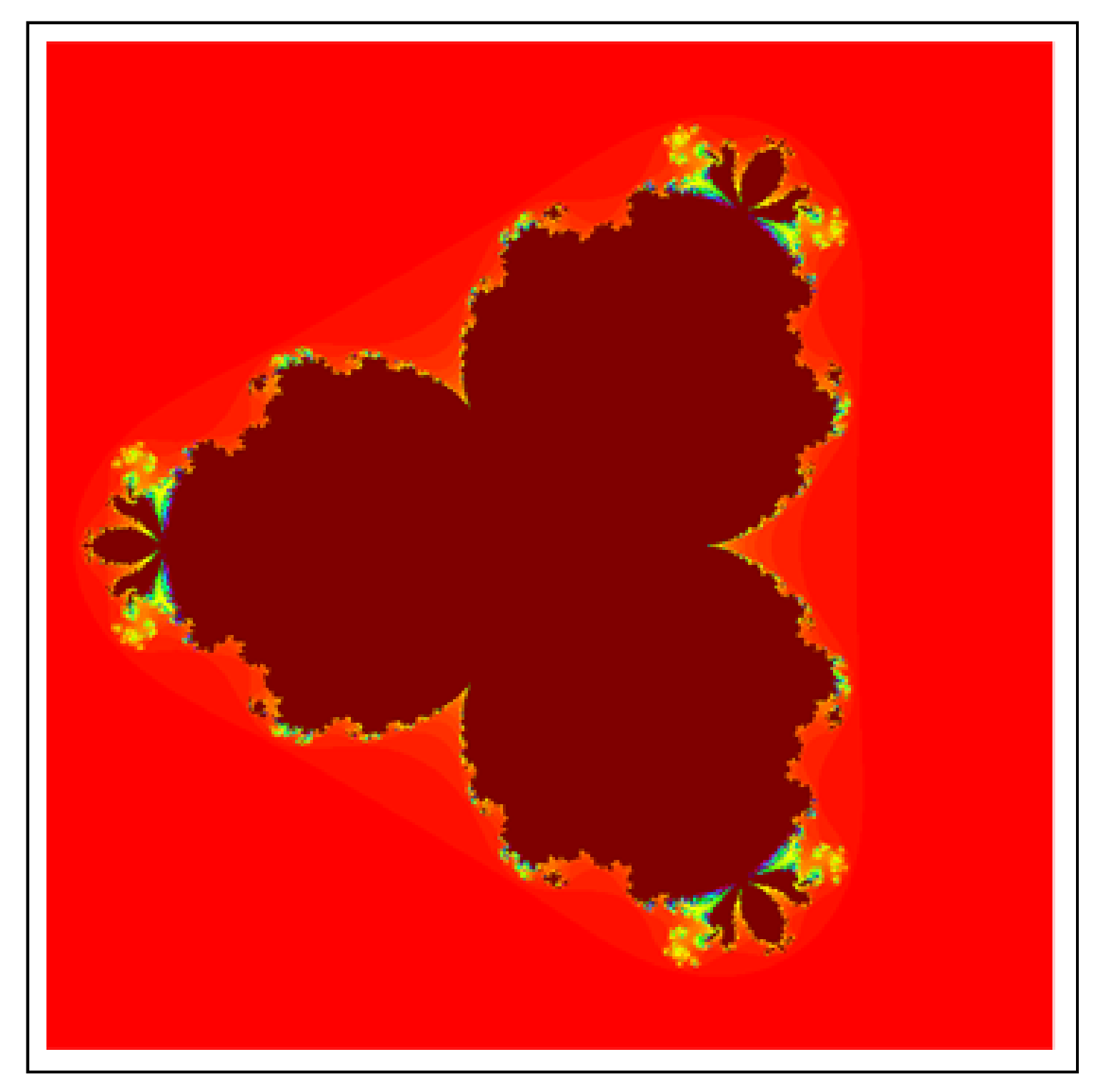


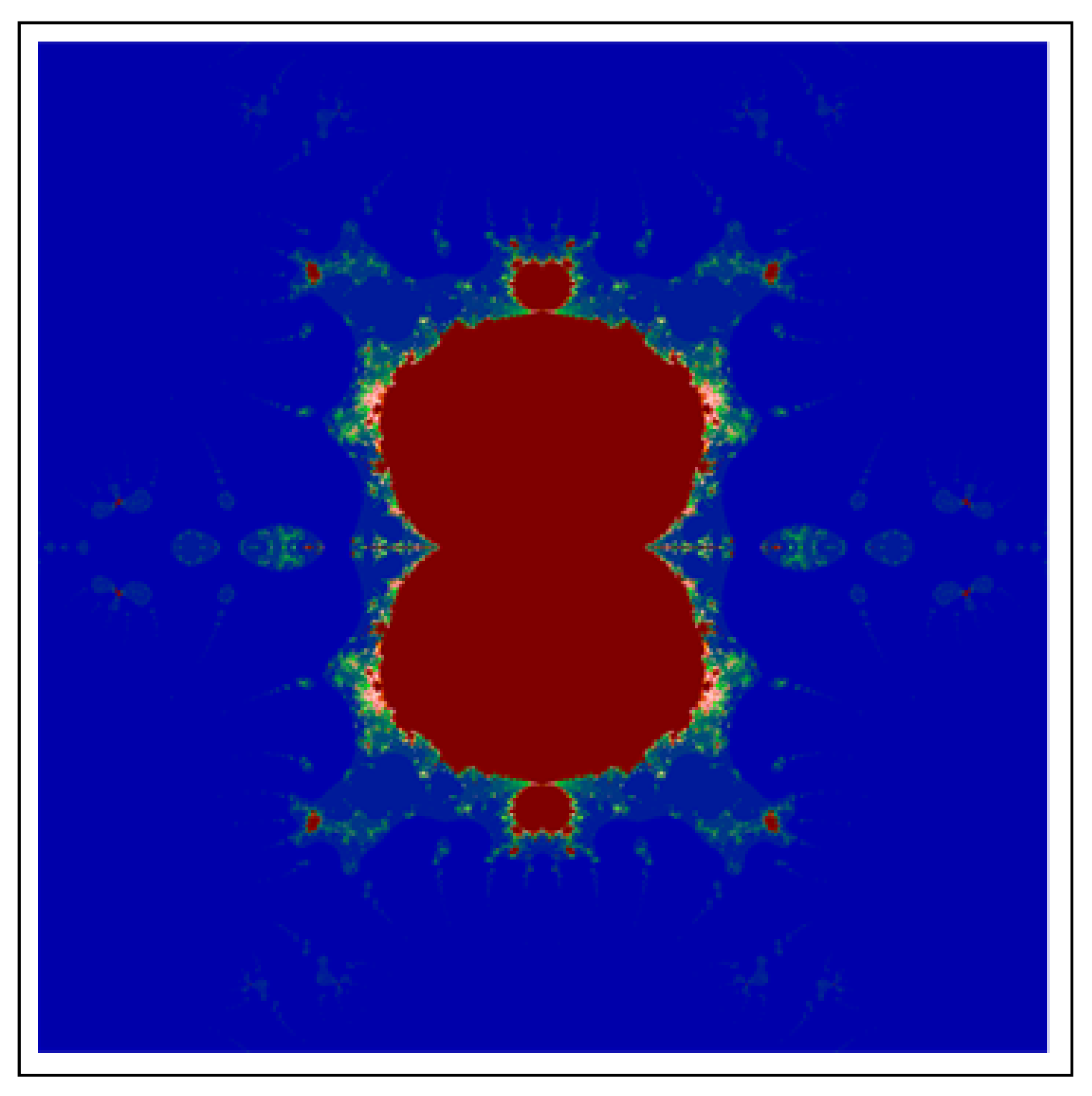
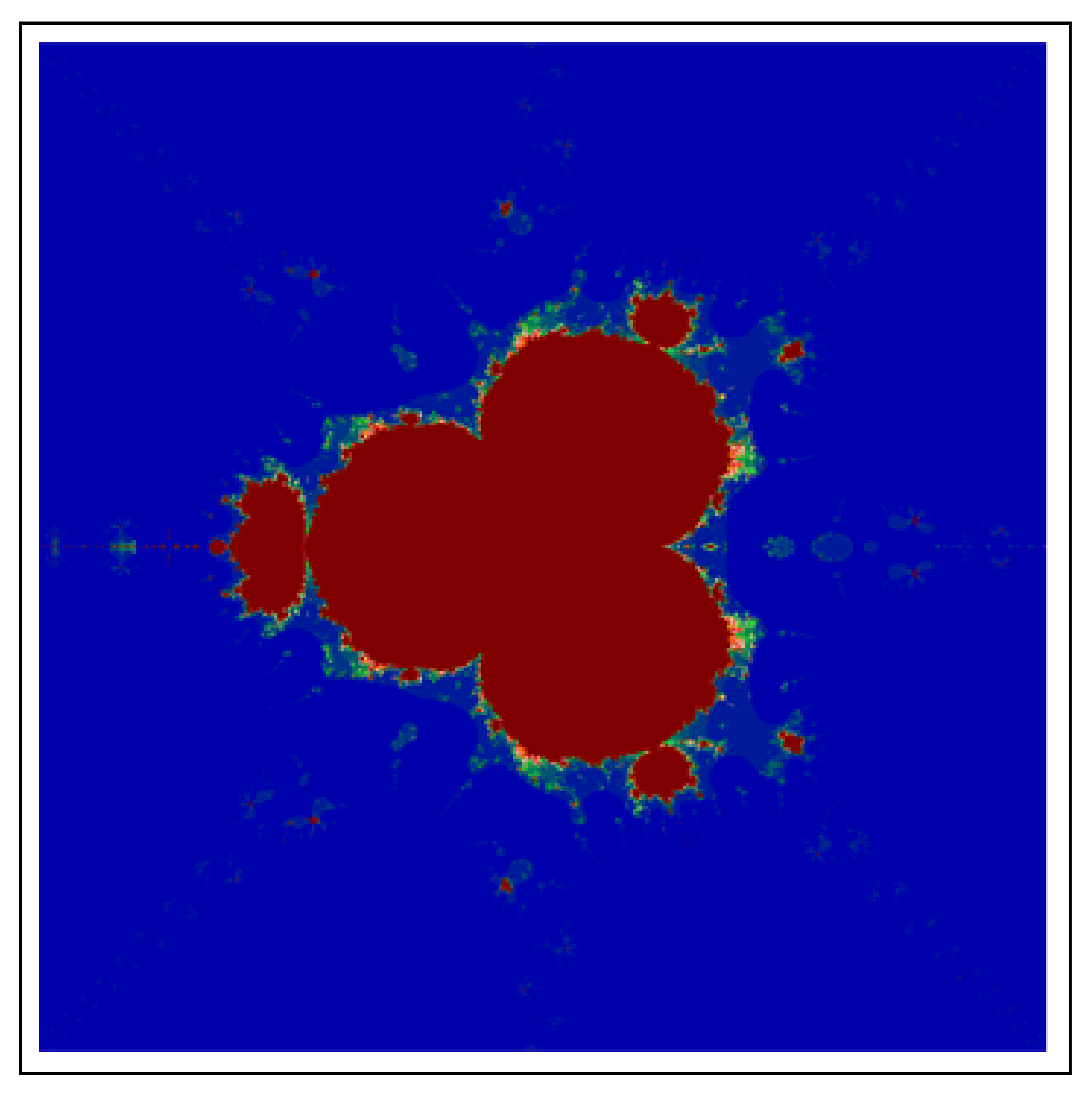
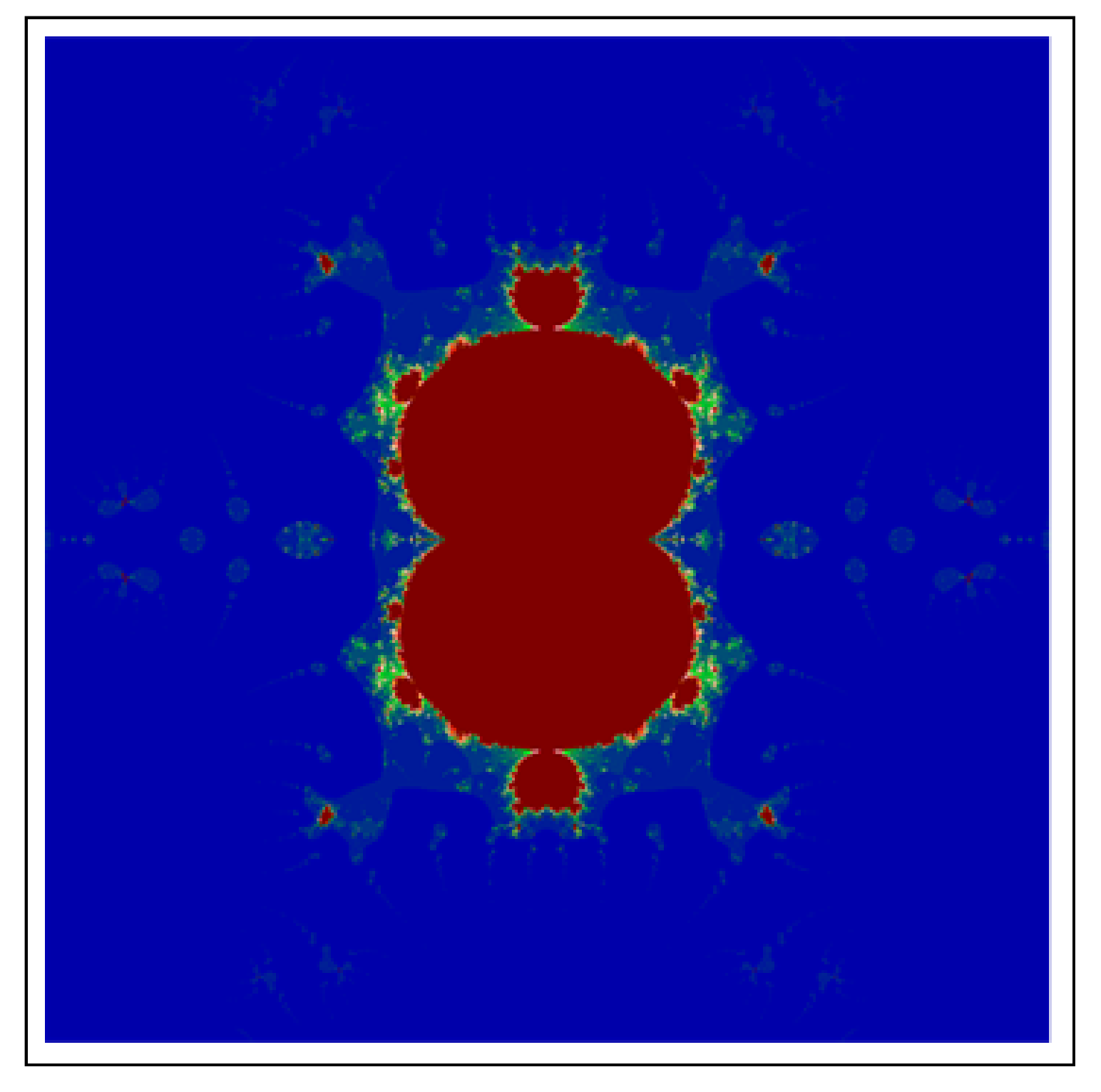
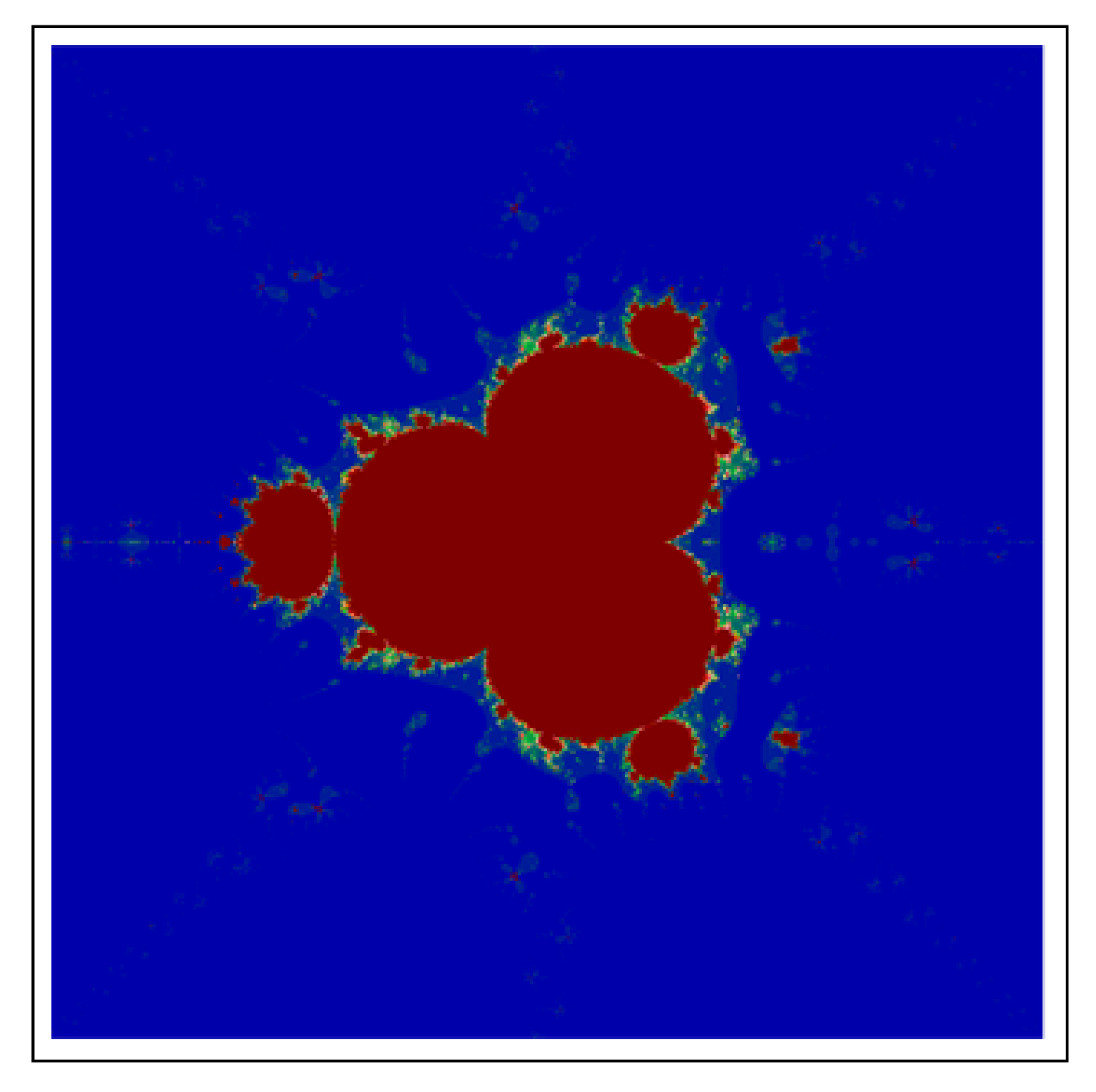
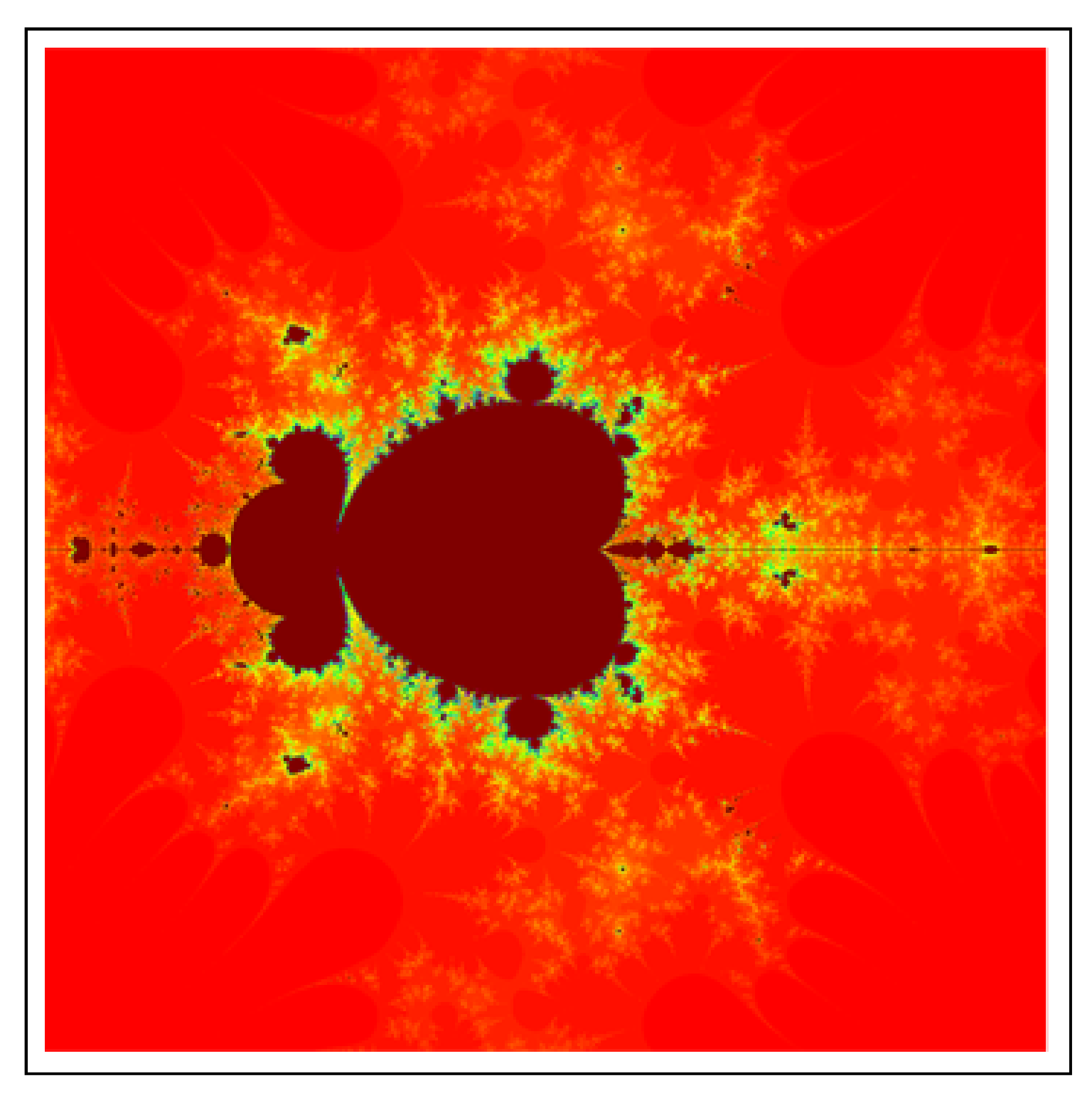
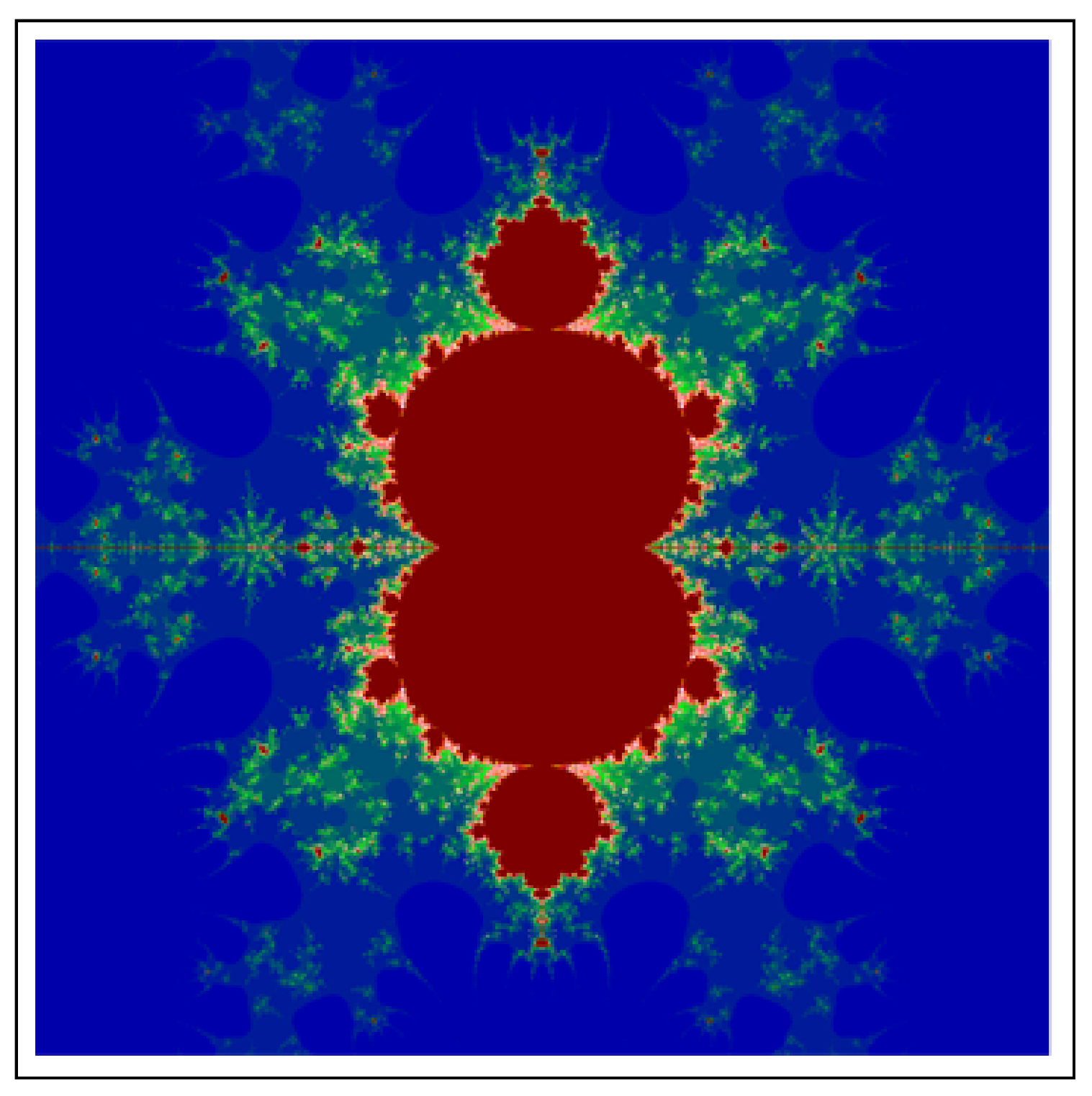
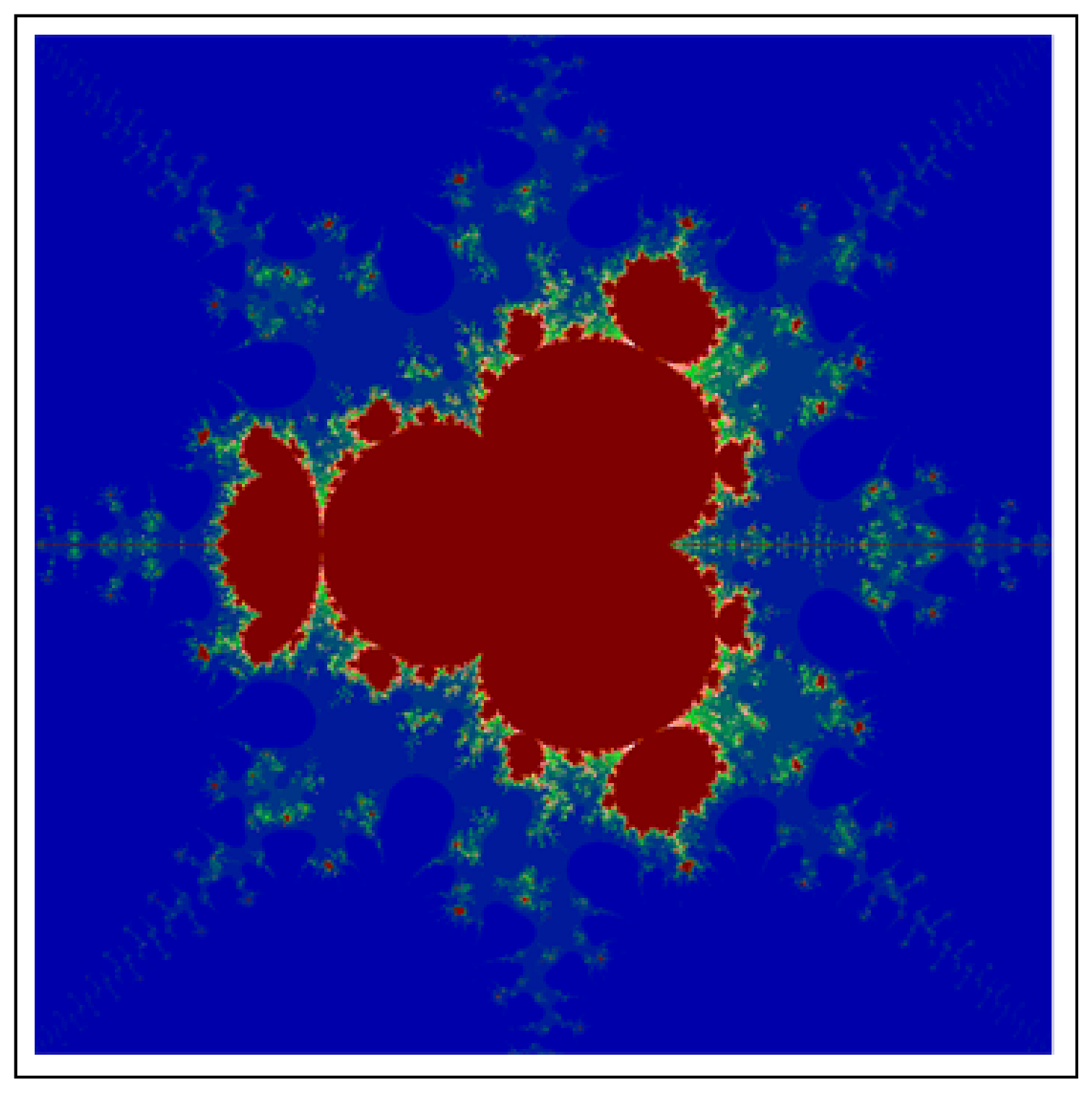
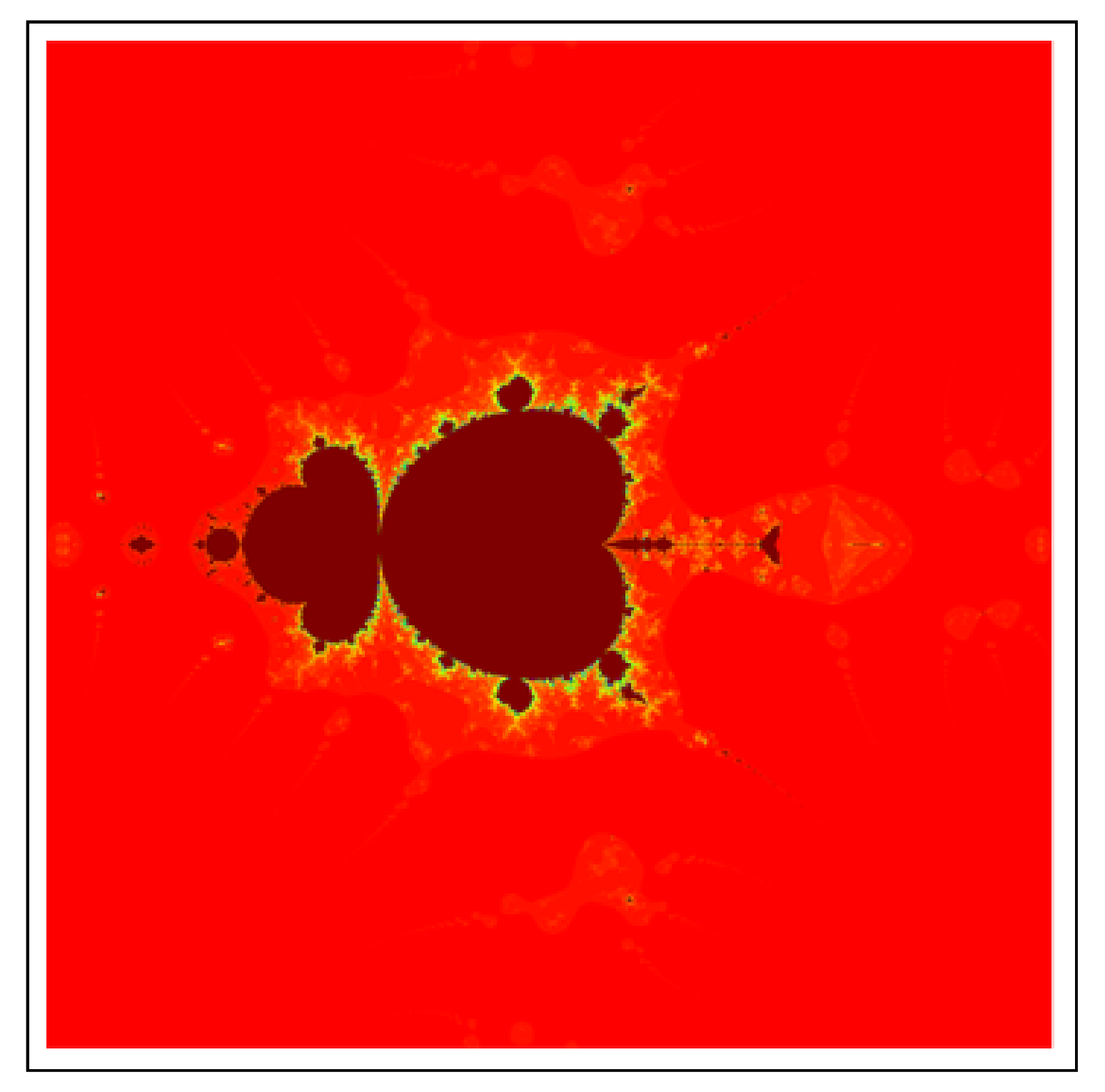
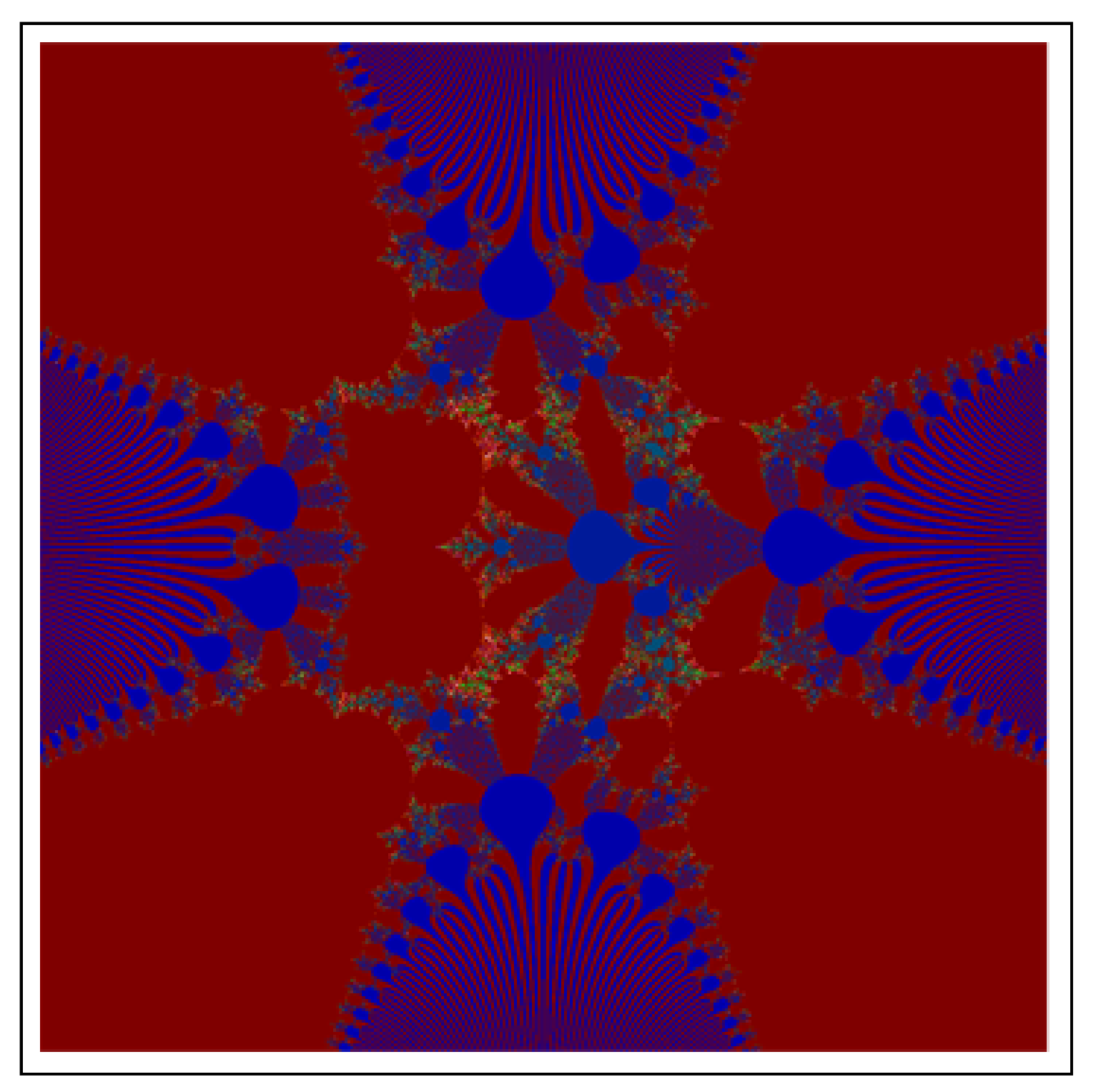
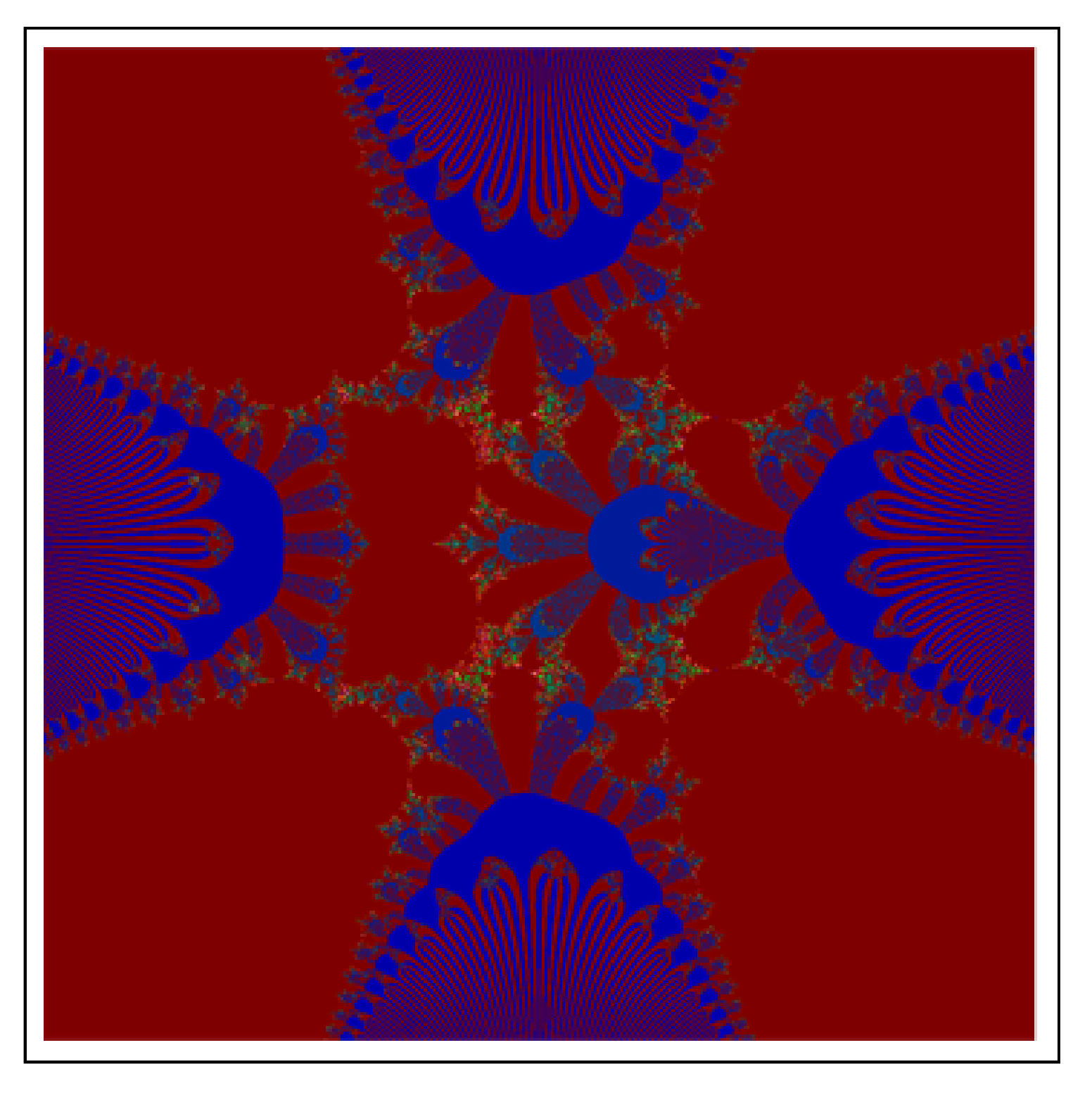

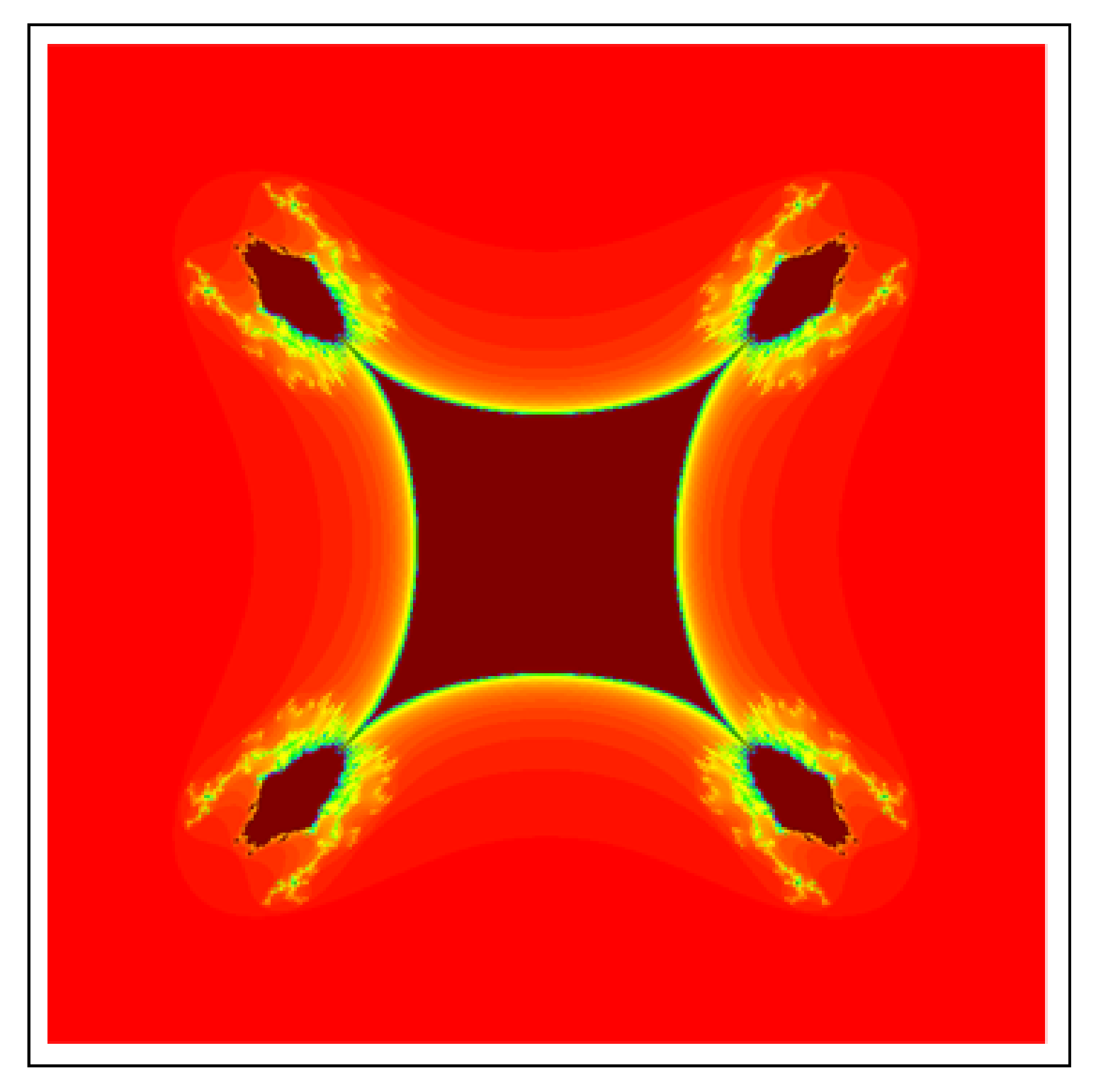

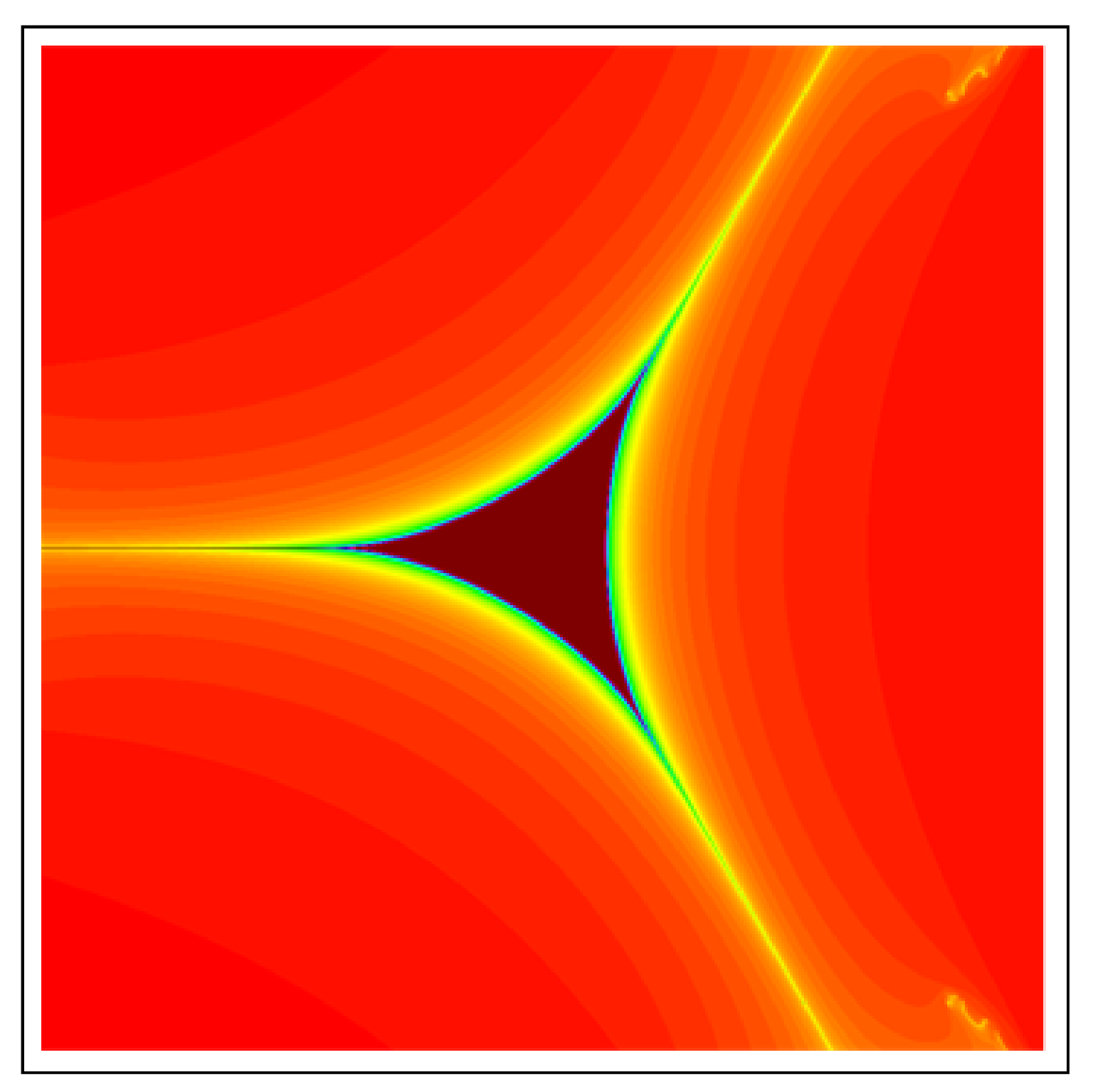
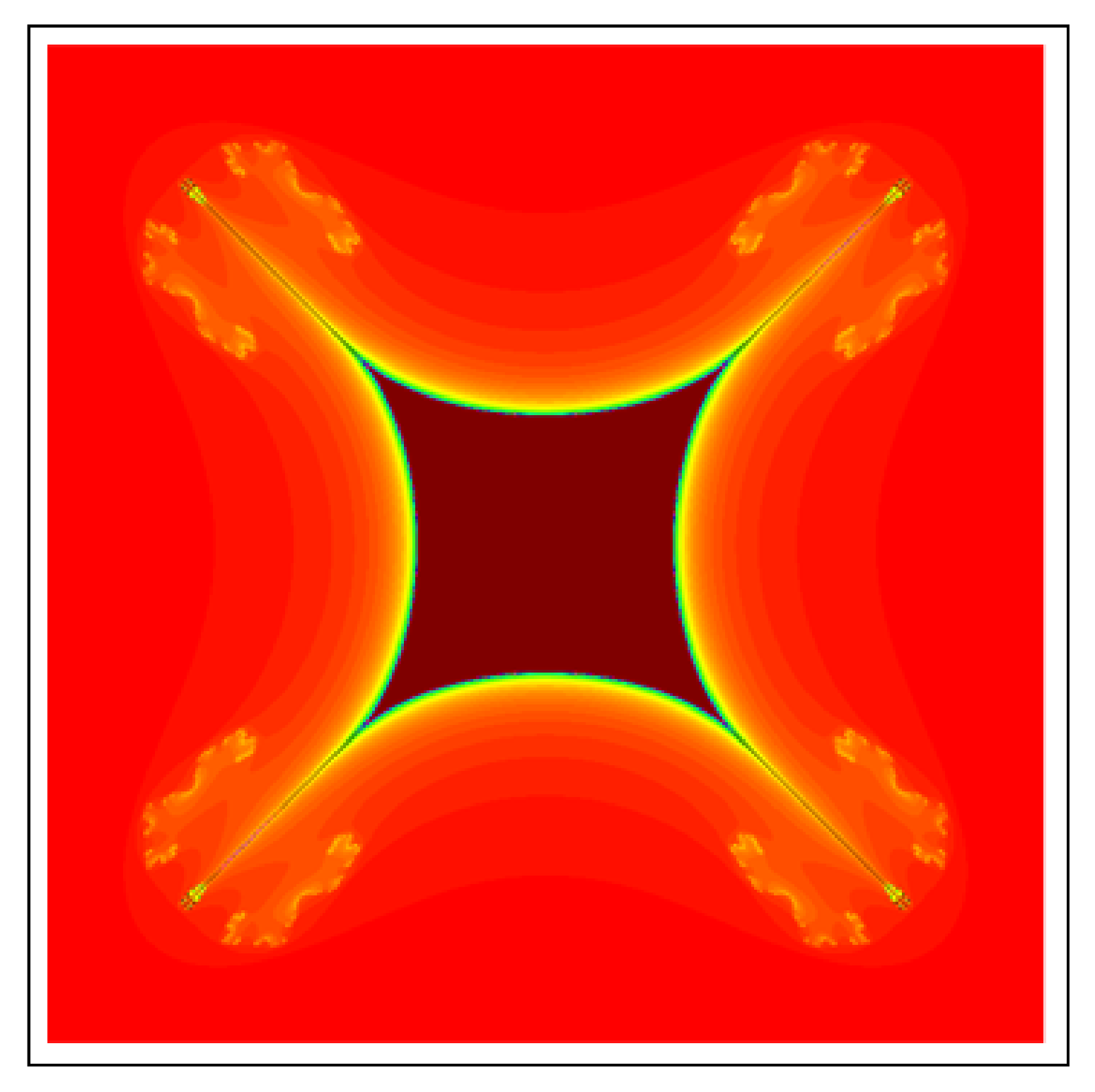
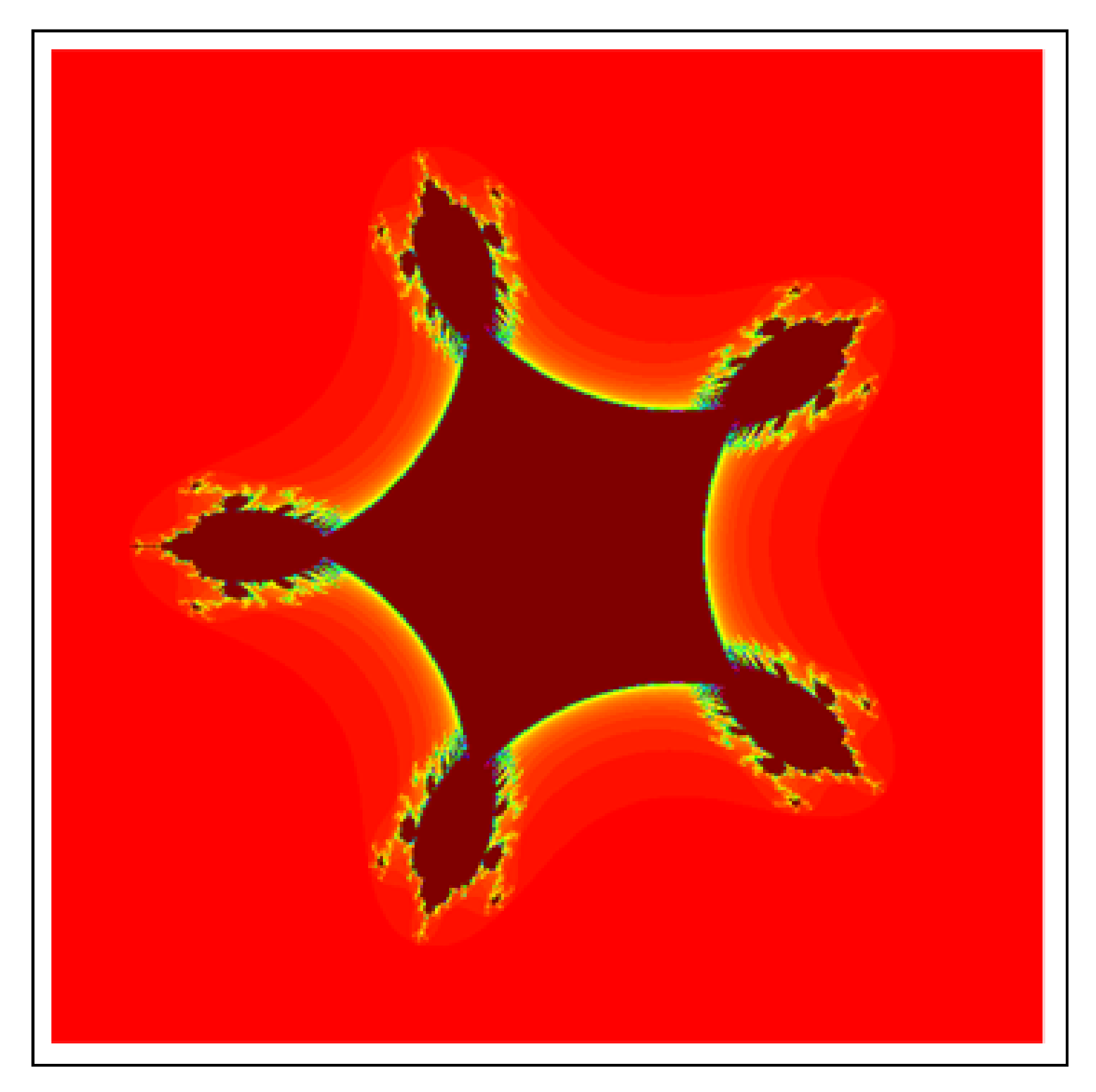
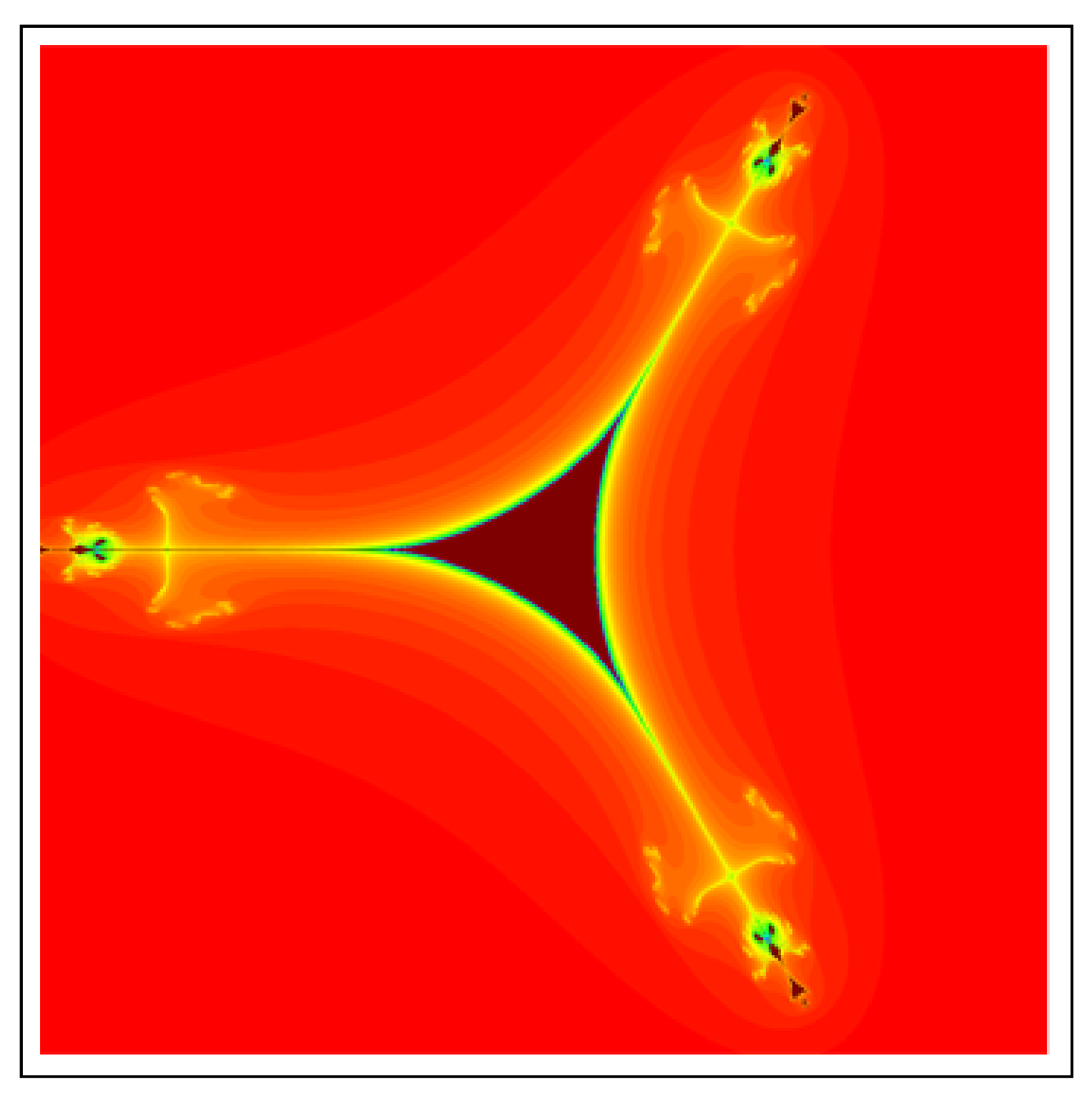
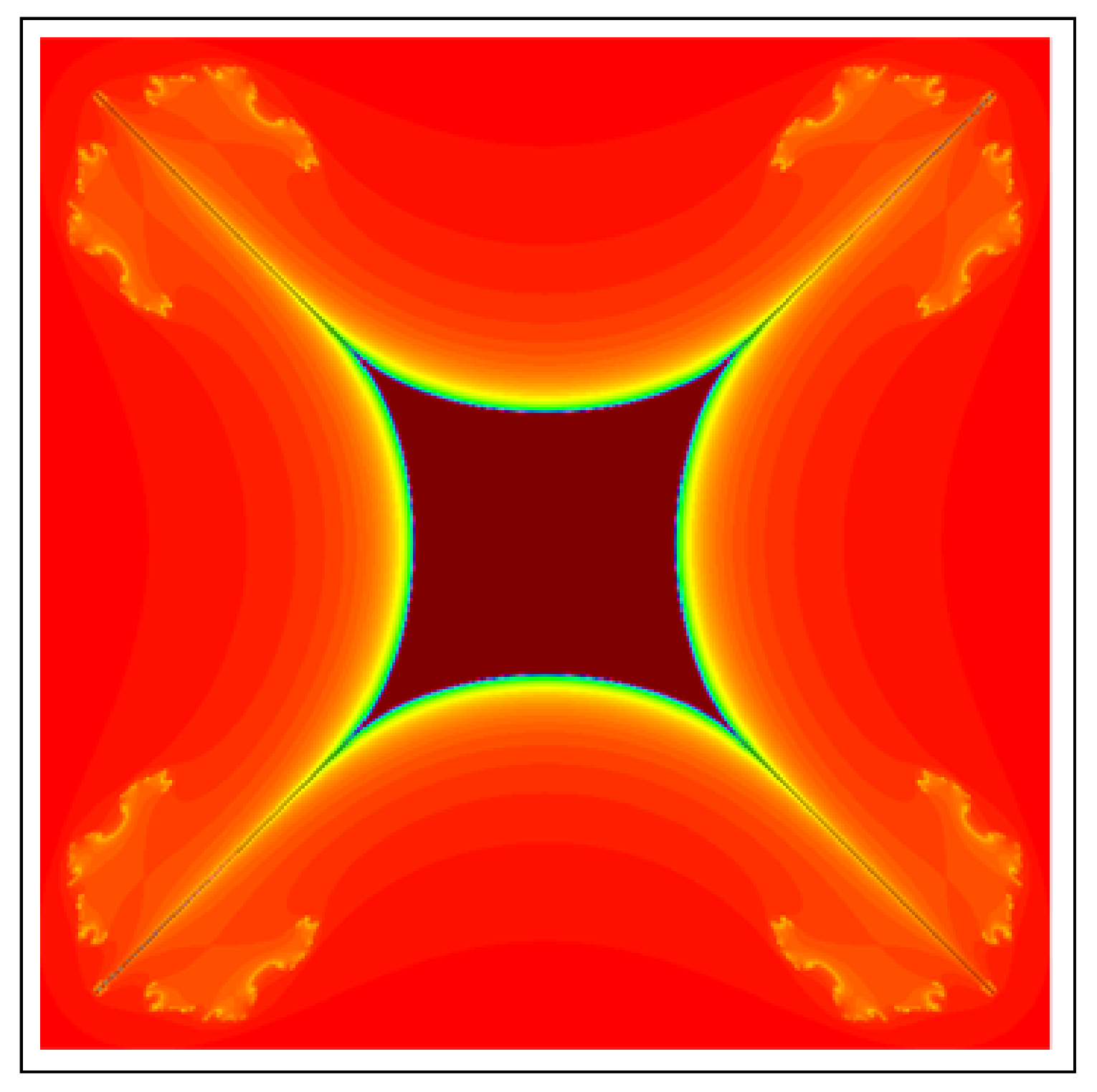
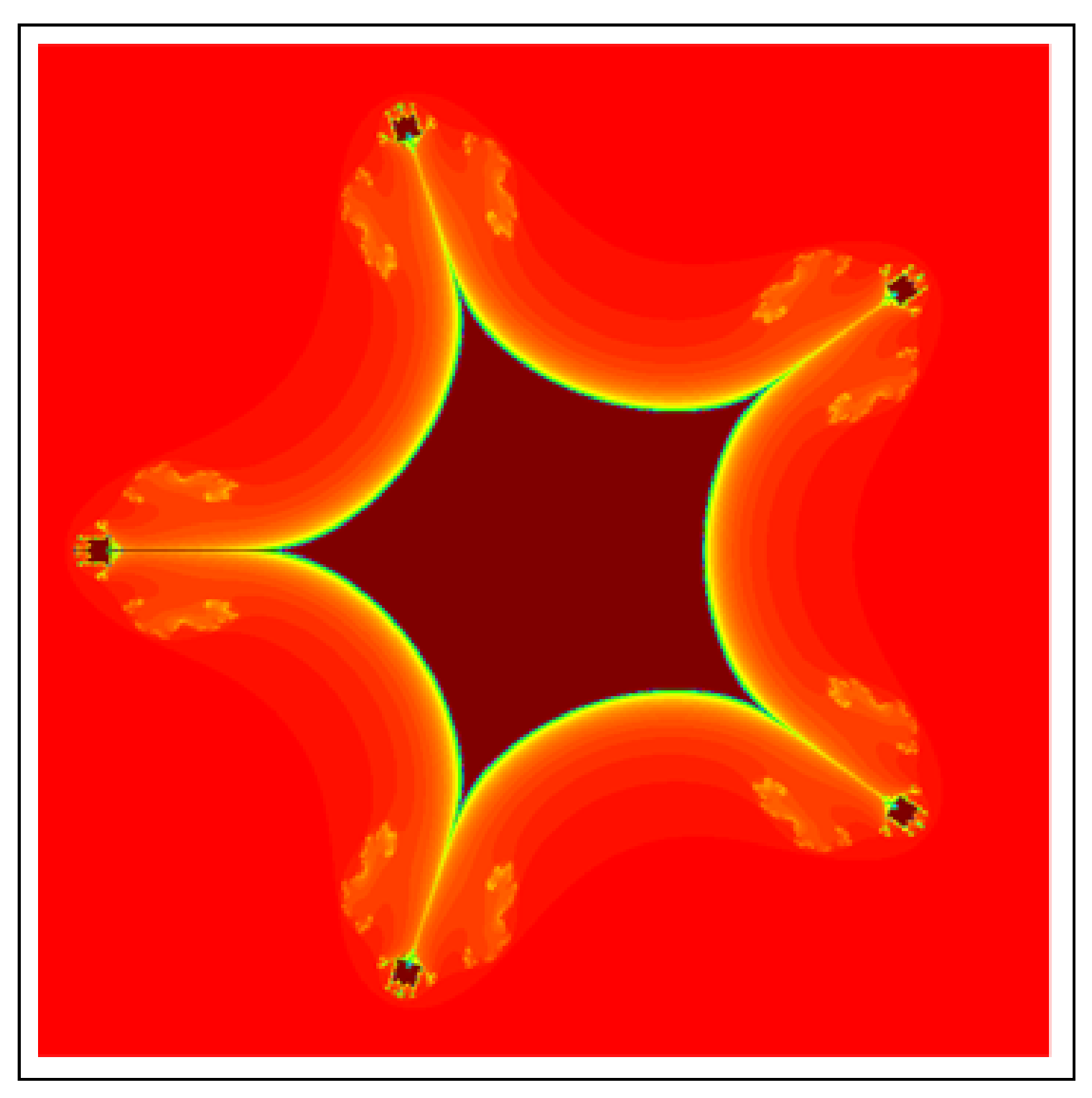
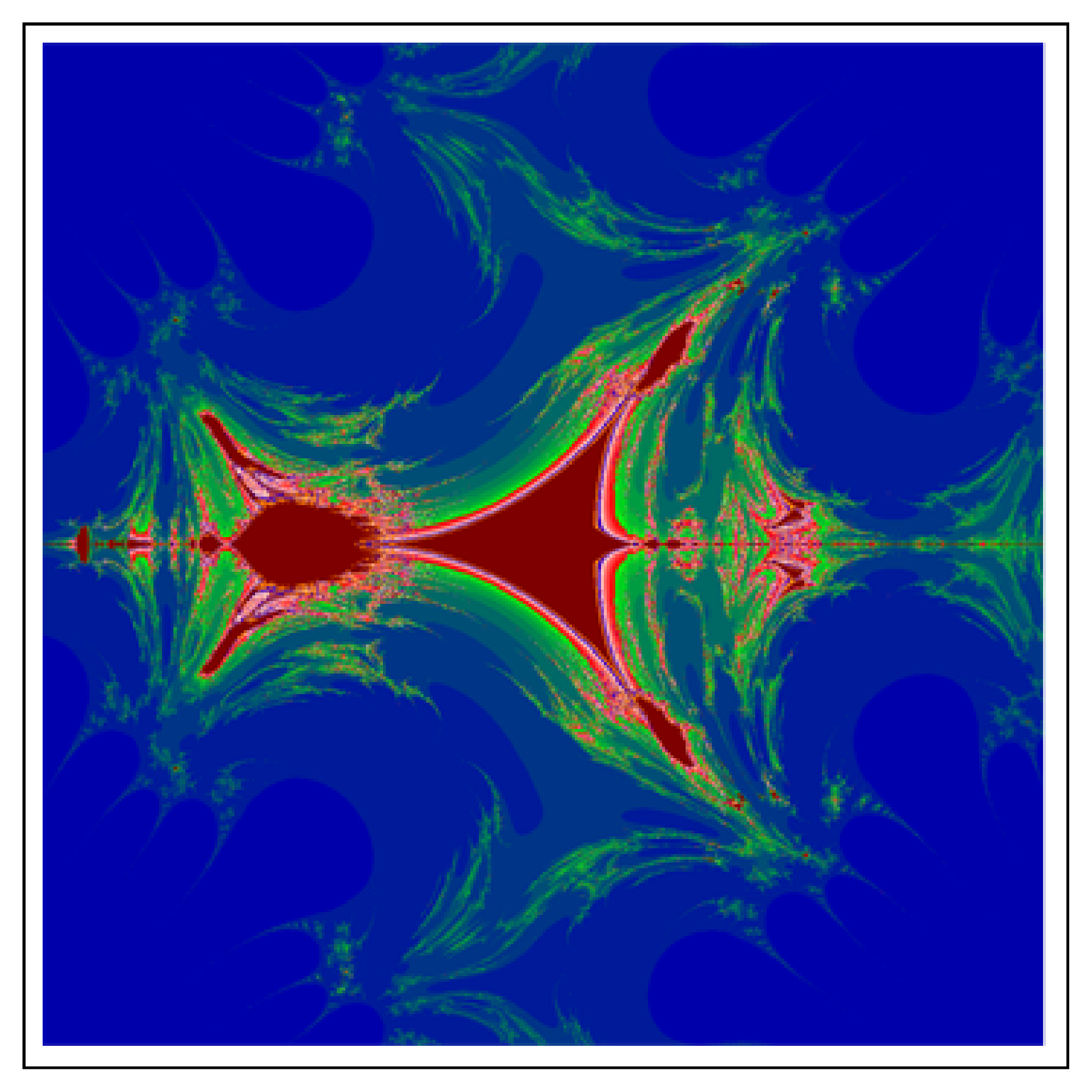
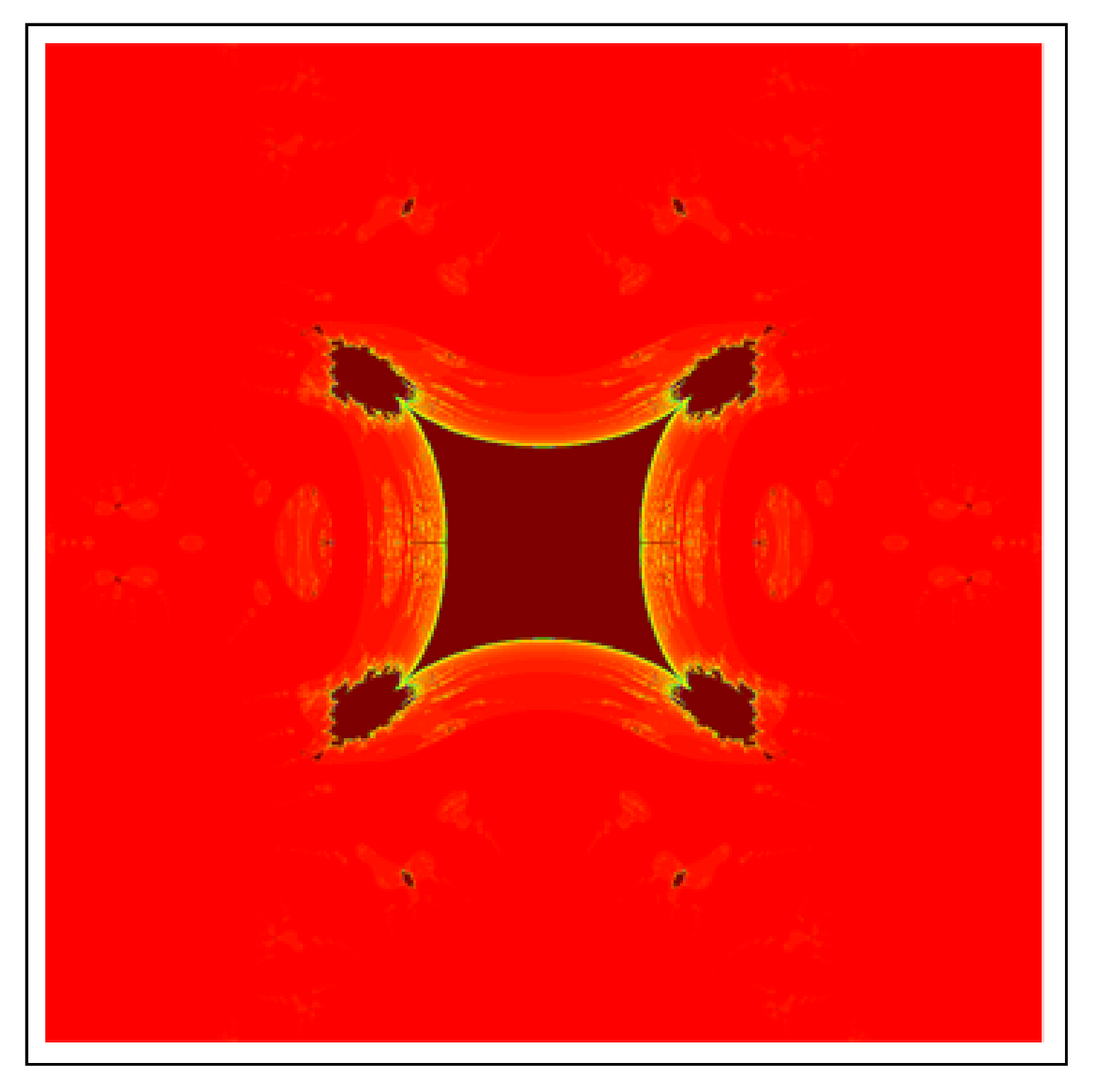
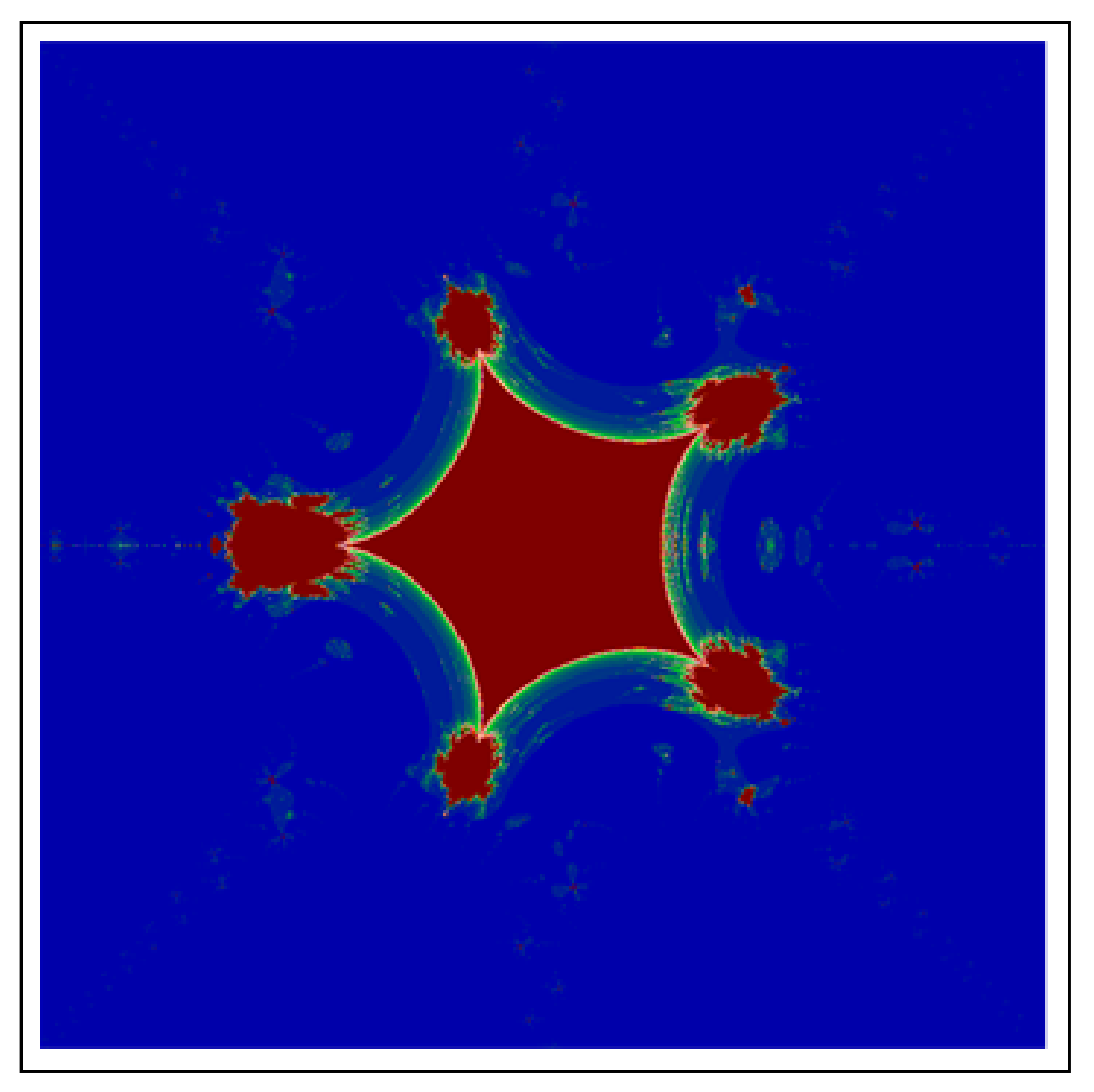
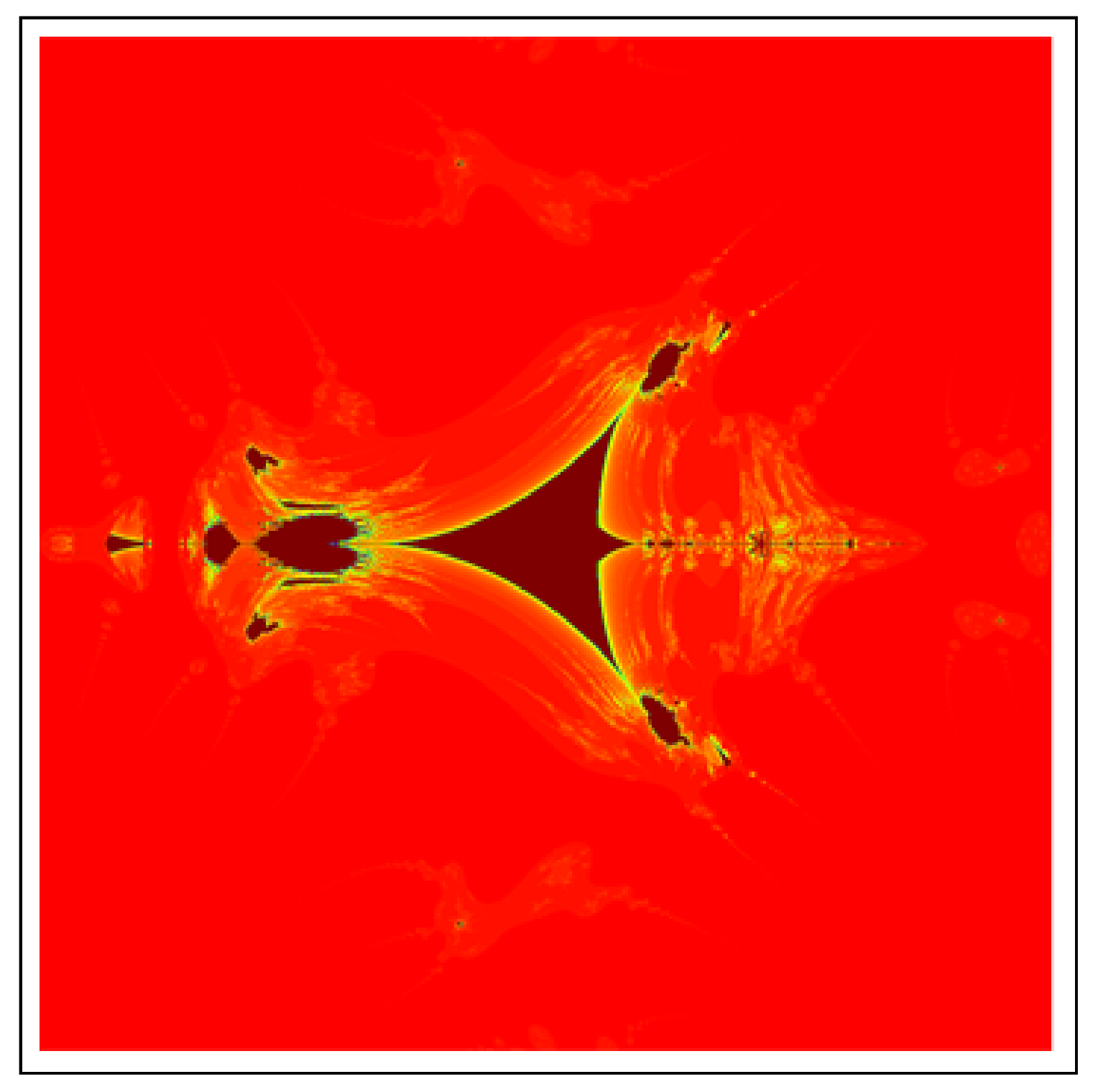
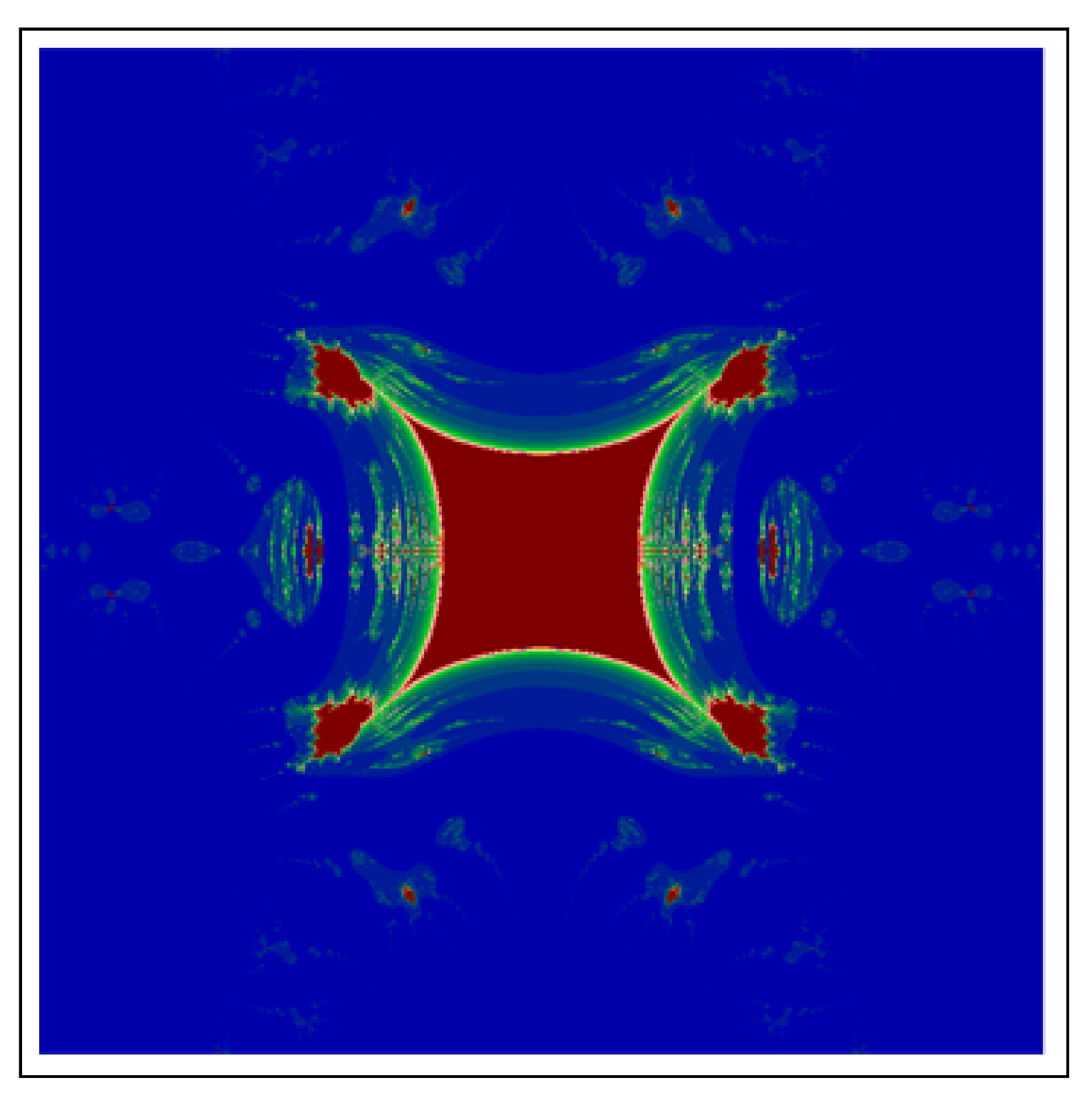
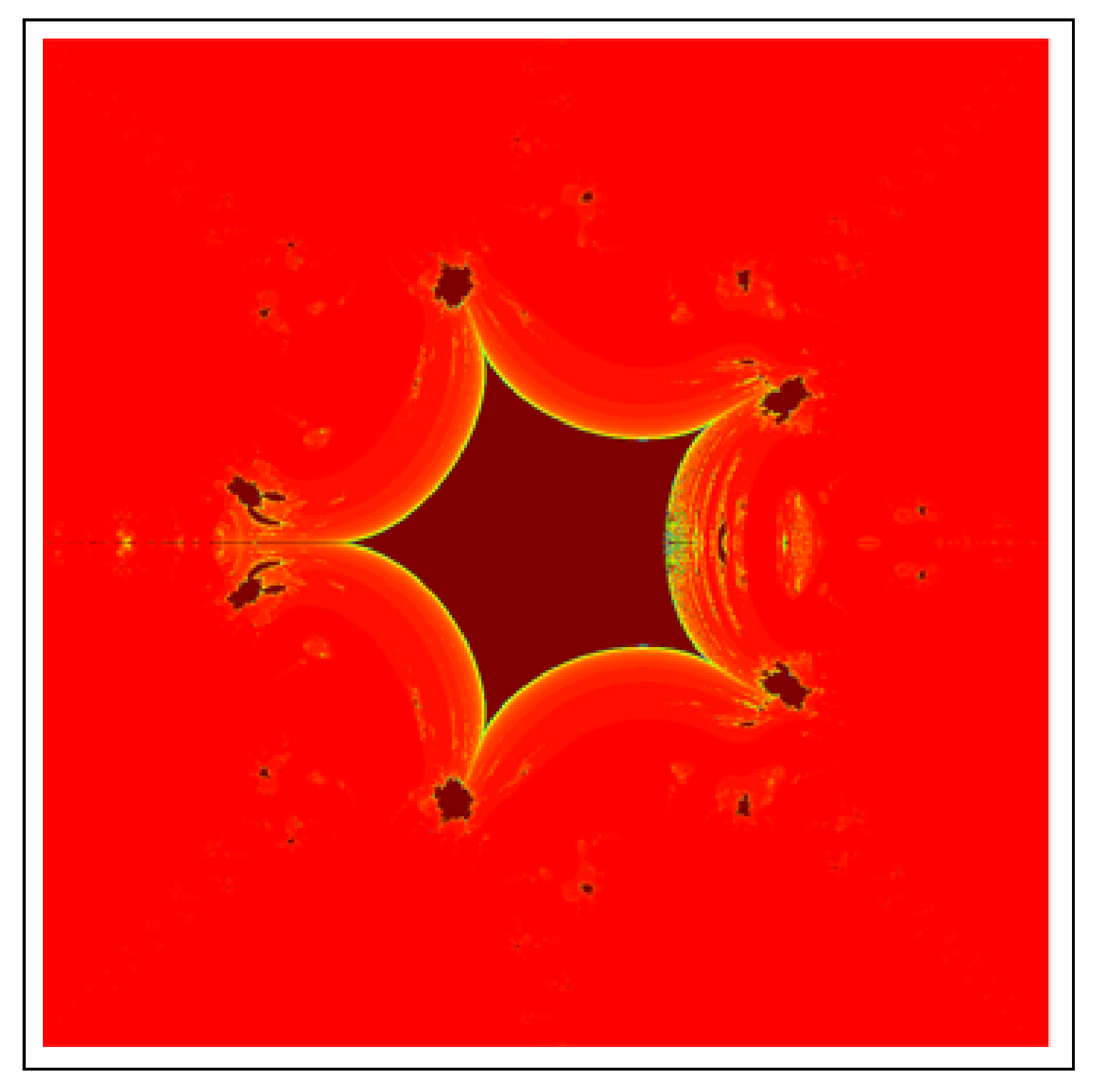

Publisher’s Note: MDPI stays neutral with regard to jurisdictional claims in published maps and institutional affiliations. |
© 2022 by the authors. Licensee MDPI, Basel, Switzerland. This article is an open access article distributed under the terms and conditions of the Creative Commons Attribution (CC BY) license (https://creativecommons.org/licenses/by/4.0/).
Share and Cite
Tassaddiq, A.; Tanveer, M.; Azhar, M.; Nazeer, W.; Qureshi, S. A Four Step Feedback Iteration and Its Applications in Fractals. Fractal Fract. 2022, 6, 662. https://doi.org/10.3390/fractalfract6110662
Tassaddiq A, Tanveer M, Azhar M, Nazeer W, Qureshi S. A Four Step Feedback Iteration and Its Applications in Fractals. Fractal and Fractional. 2022; 6(11):662. https://doi.org/10.3390/fractalfract6110662
Chicago/Turabian StyleTassaddiq, Asifa, Muhammad Tanveer, Muhammad Azhar, Waqas Nazeer, and Sania Qureshi. 2022. "A Four Step Feedback Iteration and Its Applications in Fractals" Fractal and Fractional 6, no. 11: 662. https://doi.org/10.3390/fractalfract6110662
APA StyleTassaddiq, A., Tanveer, M., Azhar, M., Nazeer, W., & Qureshi, S. (2022). A Four Step Feedback Iteration and Its Applications in Fractals. Fractal and Fractional, 6(11), 662. https://doi.org/10.3390/fractalfract6110662





